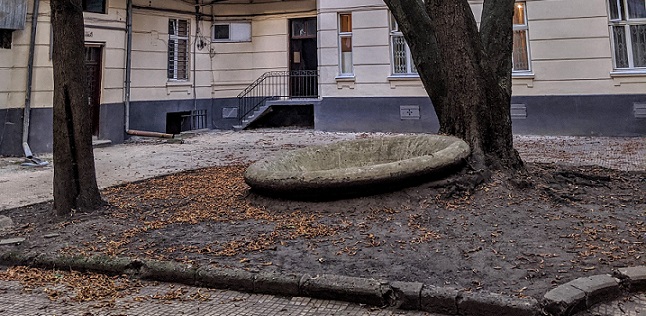An illustrated glossary of common elements of historic architecture and infrastructure in Lviv and Galicia.
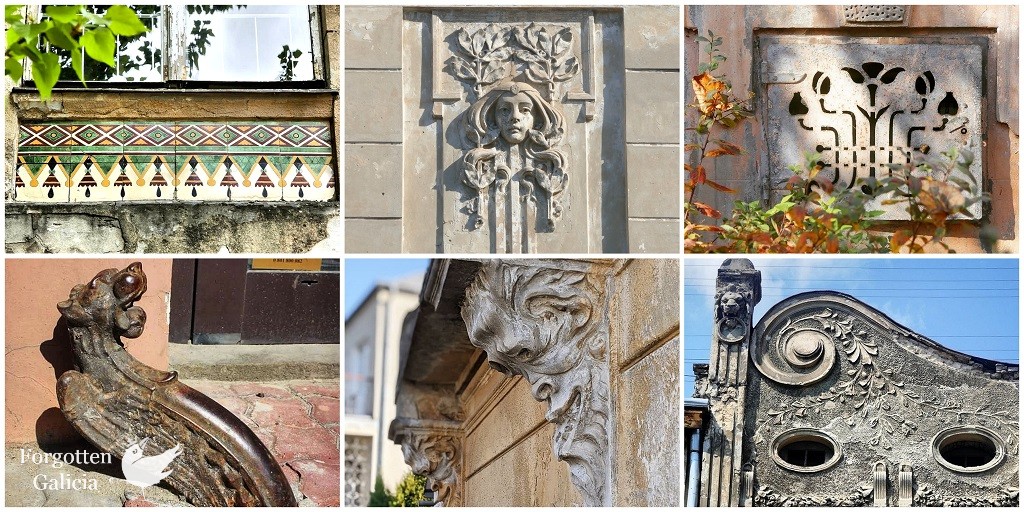
- Anchor plate
- Architrave
- Atlante
- Attic
- Avant-corps
- Baluster
- Balustrade
- Bay window
- Benchmark
- Blind arcade
- Blind arch
- Blind balustrade
- Blind window
- Boot scraper
- Bracket
- Carriage curb
- Cartouche
- Caryatid
- Ceramic tiles
- Coal elevator
- Coal tracks
- Coat of arms of Galicia
- Coat hanger
- Conscription number
- Cornice
- Egg-and-dart
- Electrical panel
- Electrical substation booth
- Festoon
- Finial
- Frieze
- Mural
- Gable
- Gallery
- Ghost sign
- Greek fret
- Guard stone
- Guttae
- Hand pump
- Keystone
- Lincrusta
- Majolica
- Manufacturer’s mark
- Marker plate
- Mascaron
- Masonry heater
- Mezuzua slot
- Modernist flagpole
- Newel post
- Niche
- Overdoor
- Pediment
- Pilaster
- Polish roof
- Porte-cochère
- Porthole
- Portico
- Quoins
- Radiant sun motif
- Recessed portal
- Relief
- Roller shutter
- Rosette
- Rustication
- Sgraffito
- Six-petal rosette
- Skylight
- Street sign plaques
- Terrazzo
- Triglyph
- Utility covers
- Urine deflector
- Vacuum inlet
- Vault light
- Vault window
- Ventilation window
- Volute
- Wagner’s wreath
- Wall lantern
- Well basin
Anchor plate
[ Укр: аграфи, анкери, стяжки ]
Alternative names: wall washer, pattress plate, masonry star
Used to reinforce the structure of masonry buildings. Made from cast or wrought iron, the plates connect to rods that penetrate a building.
In Lviv and Galicia, found especially in 19th century Historicist buildings.
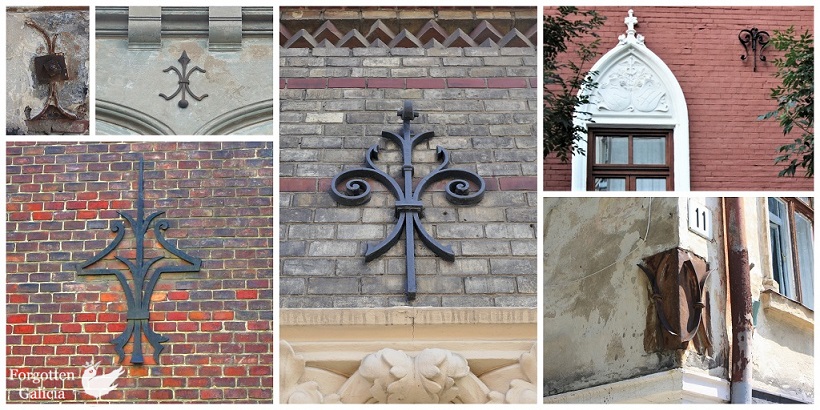
Architrave
The molded frame around a doorway or window.
Lugged or eared (on left) and shouldered (on right) architraves found especially in Baroque and Neo-Baroque architecture.
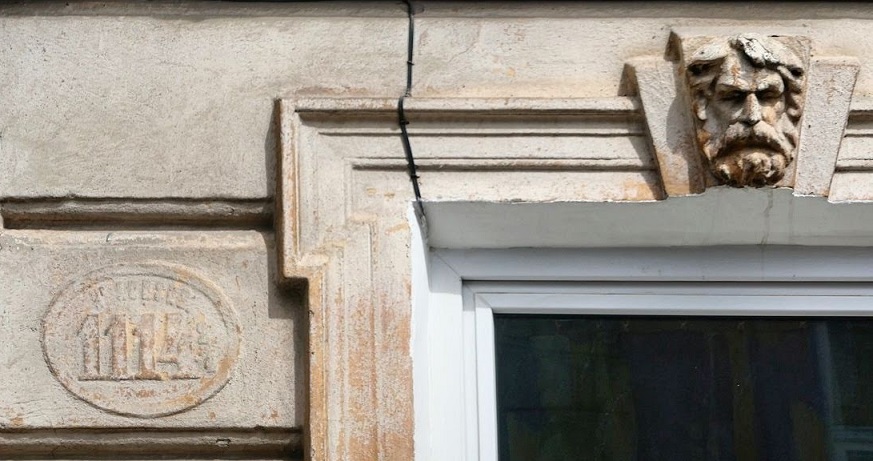
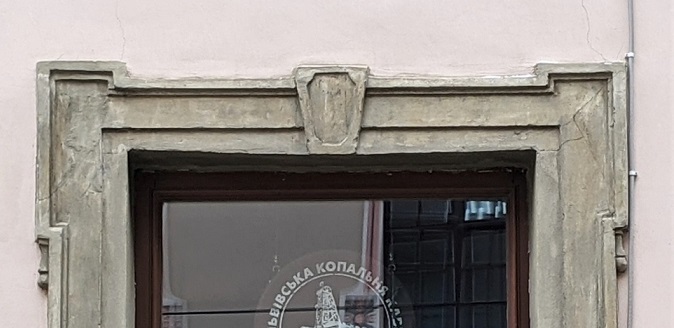
Atlante
[ Укр: Атланти ]
Alternative names: atlas, atlant (atlante), atlantid; plural atlantes
A support sculpted in the form of a man, which may take the place of a column, a pier, or a pilaster.
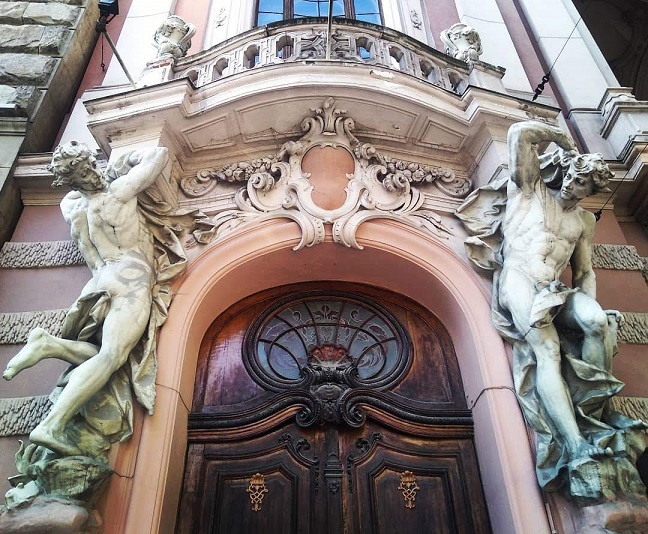

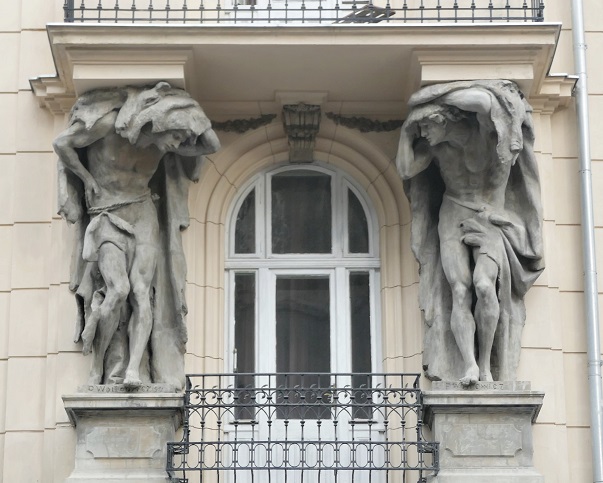
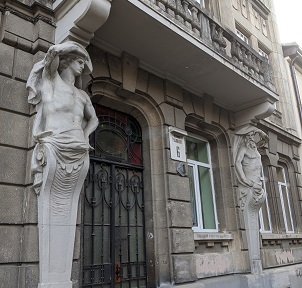
Attic
[ Укр: аттик ]
А story or low wall above the cornice of a classical façade.
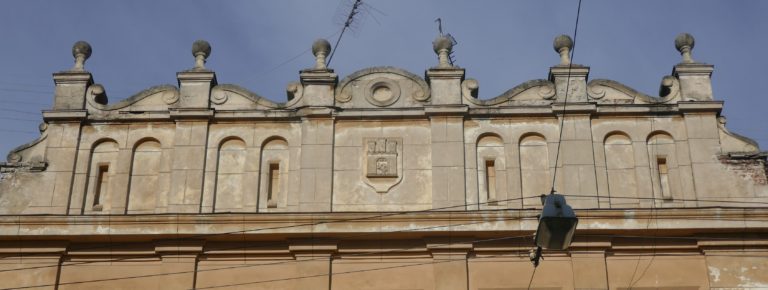
Avant-corps
[ Укр: ризаліт ]
А part of a building, such as a porch or pavilion, that juts out from the principal block of a building, often taller than other parts of the building.
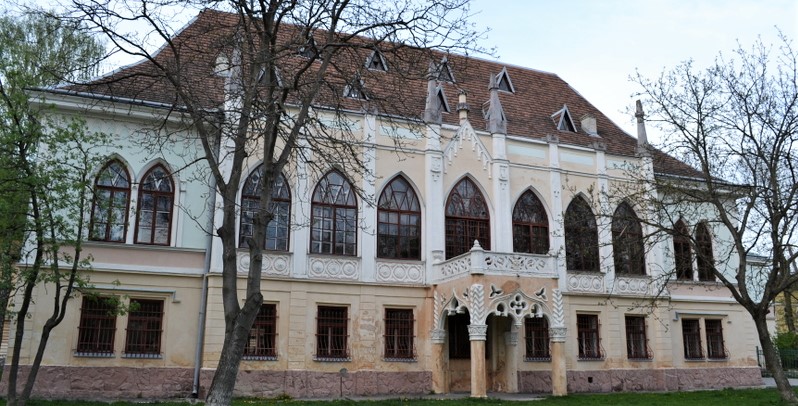
Baluster
[ Укр: балясина ]
А small shaped pillar supporting a coping or rail.
Vase-shaped balusters commonly found in Baroque architecture.

Balustrade
[ Укр: балюстрада ]
An open row of balusters forming the protective edge of a balcony or a change of level.

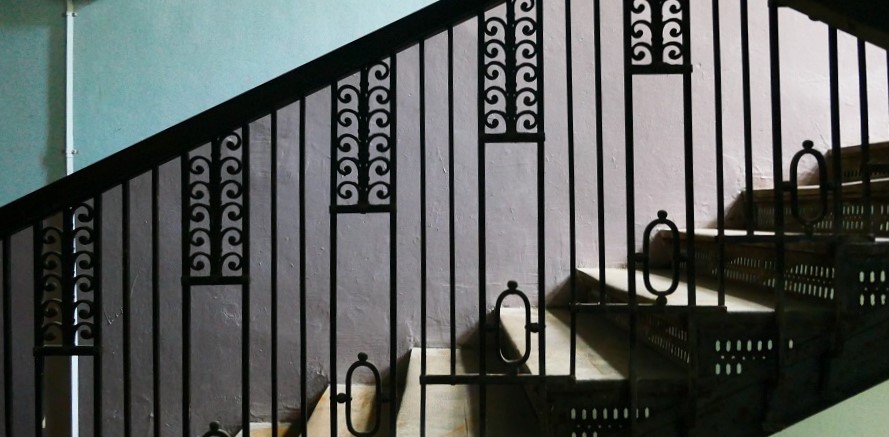

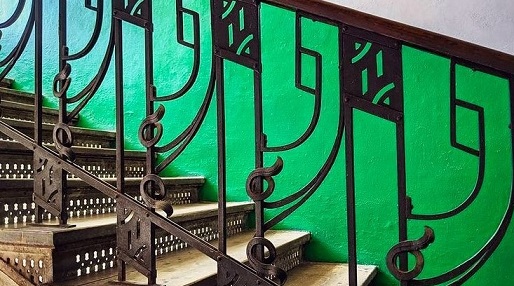
Bay window
[ Укр: еркер ]
A window space projecting outward from the main walls of a building and forming a bay in a room.
A bay window supported by a corbel, bracket or similar is called an oriel window.
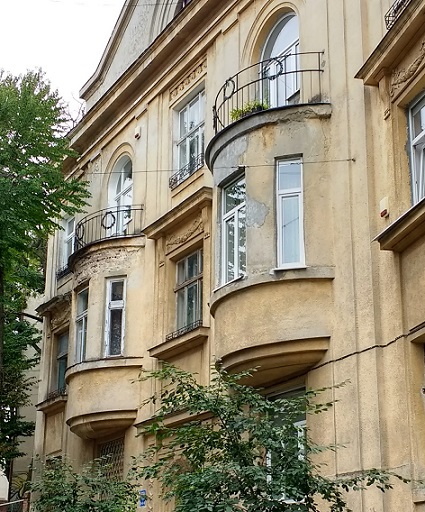



Benchmark
[ Укр: репер, реперна точка ]
A geographic point whose elevation has been measured and recorded to a high level of accuracy.
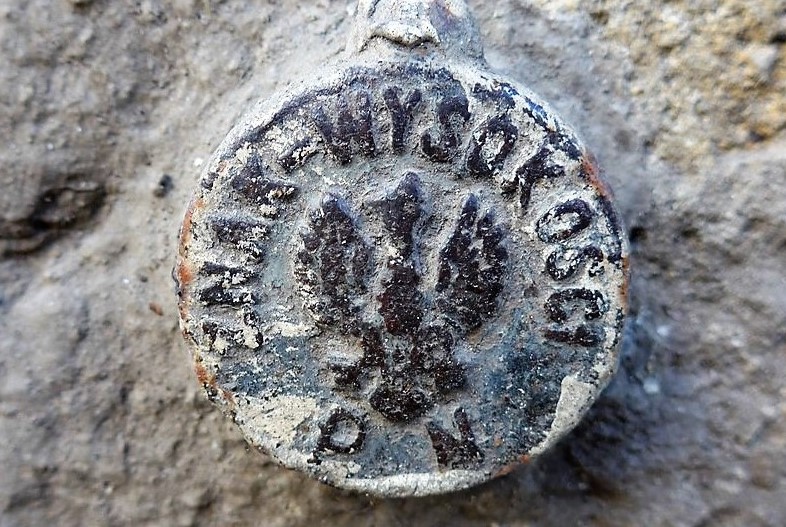
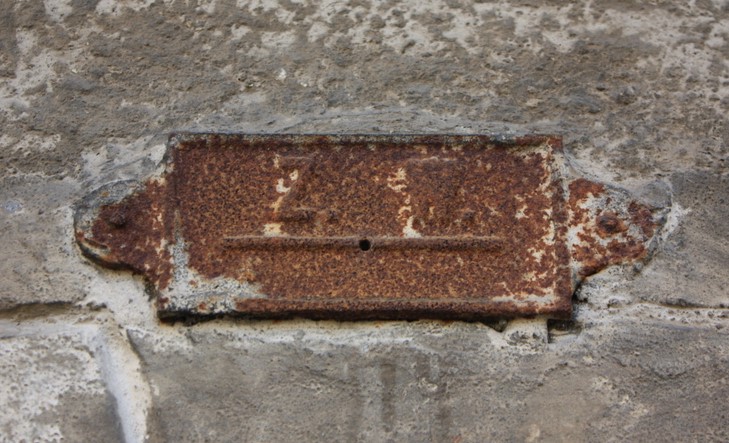
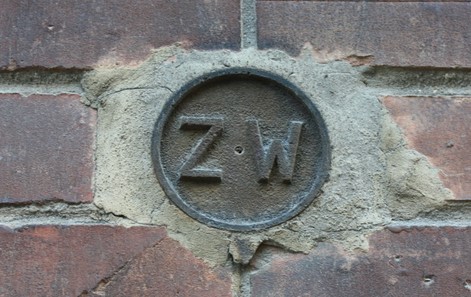
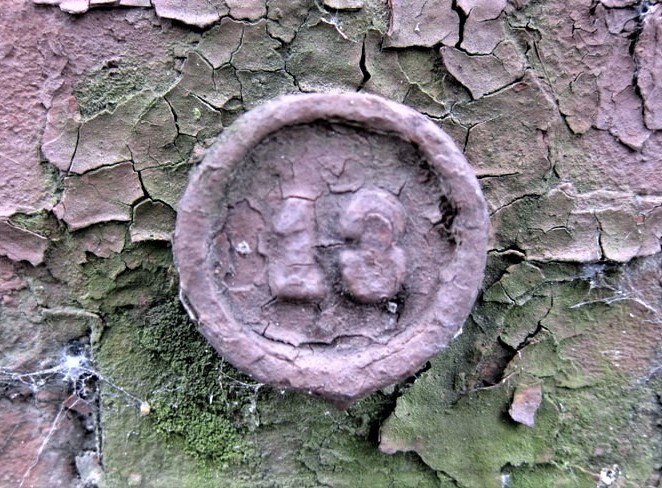
Blind arcade
An arcade that is composed of a series of arches with well-defined columns that has no actual openings and that is applied to the surface of a wall as a decorative element.
A common decorative feature on the facades of Romanesque and Gothic buildings throughout Western Europe, and also in Byzantine Orthodox churches in Eastern Europe. Also found on Renaissance synagogues in Galicia.

Blind arch
Alternative name: Lombard band
A single arch or a series of joined arches applied to the surface of a wall as a decorative element, as a frieze. Originally found in Romanesque and Gothic architecture.
In Lviv, found in Neo-Romanesque and Neo-Gothic architecture.

Blind balustrade
[ Укр: сліпа балюстрада ]
An architectural feature applied to the wall surface to add ornamentation to the façade or to keep uniformity with real balconies or balustrated windows.
In Lviv, found in Historicism (neo-Baroque, neo-Renaissance, neo-Gothic) as well as in Baroque-inspired Secession and neo-Classicism/Art Deco.

Blind window
[ Укр: сліпе вікно ]
An architectural feature that is shaped like a window but without any openings, above all to keep uniformity within and/or to embellish a façade.
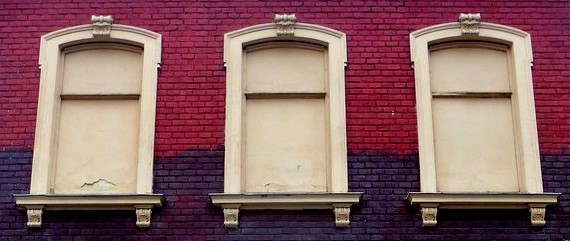
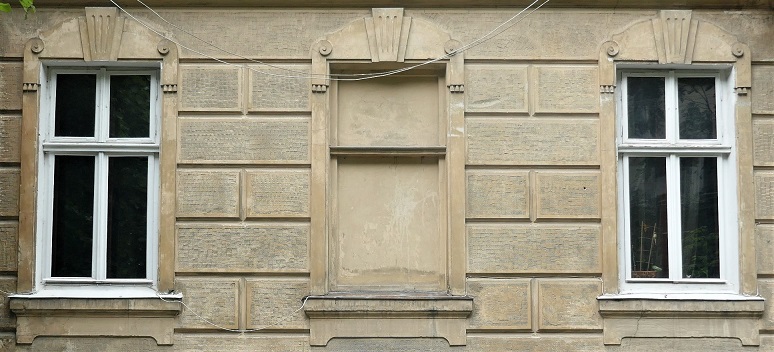
Boot scraper
[ Укр: скребачка, шкрабачка ]
An element made of metal (often cast iron) located typically near a front door of a building and used to clean boots before entering. Can be free standing, attached to railings, or in niches.
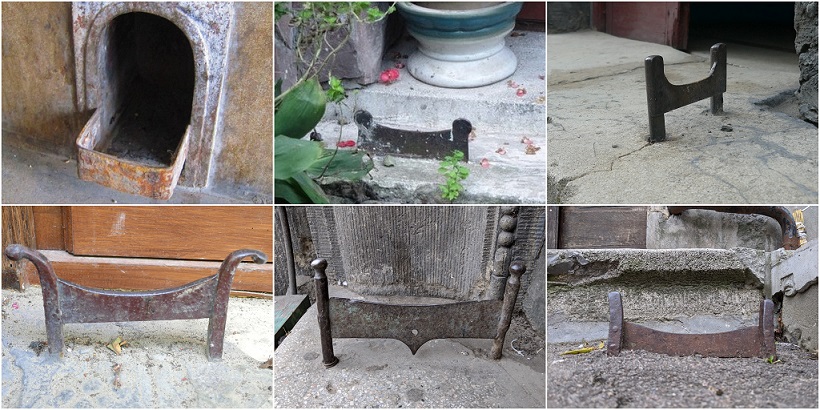
Bracket
[ Укр: кронштейн (консоль) ]
A device of wood, stone, or metal that projects from or overhangs a wall to carry a weight. It may also serve as a ledge to support a statue, the spring of an arch, a beam, or a shelf. Brackets are often in the form of volutes, or scrolls, and can be carved, cast, or molded.
Among the types of bracket are the corbel and the console, the latter of which typically has a scroll-shaped profile.
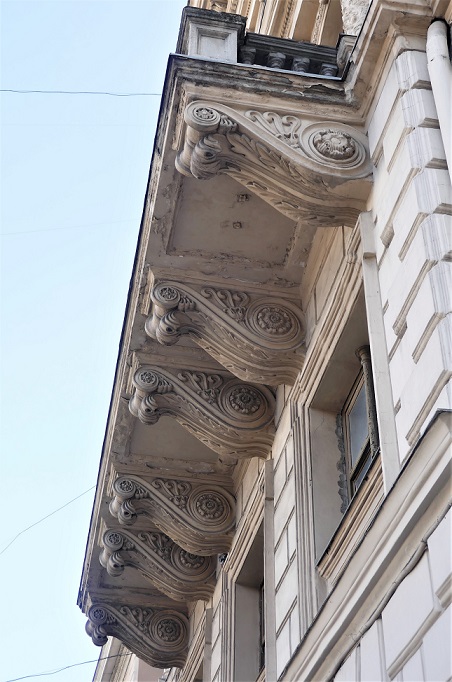
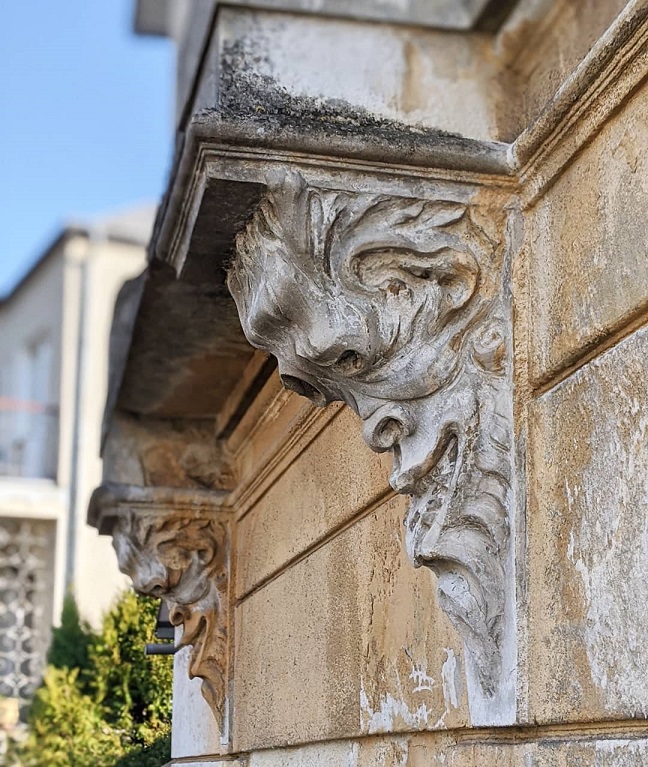
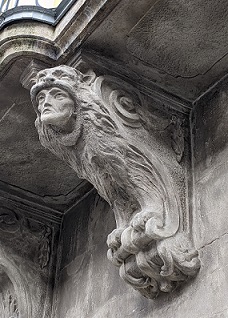

Carriage curb
An elevated platform at the sides of a carriage entryway, which acts as a curb for the carriage not to bump into the walls. It may have also been used as a sidewalk to walk past a carriage or other vehicle in the driveway, or as a carriage step.
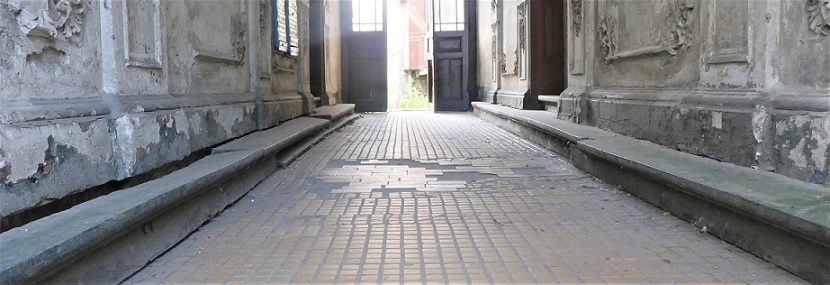
Cartouche
[ Укр: картуш ]
An oval or oblong design with a slightly convex surface, typically edged with ornamental scrollwork.
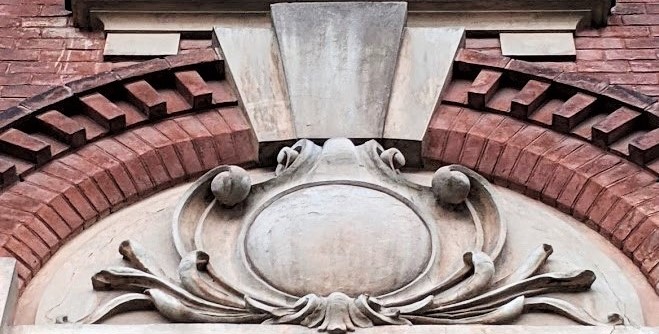
Caryatid
A sculpted female figure serving as an architectural support taking the place of a column or a pillar supporting an entablature on her head.
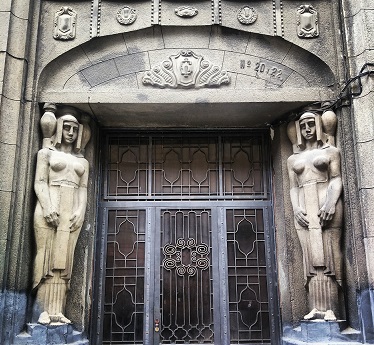
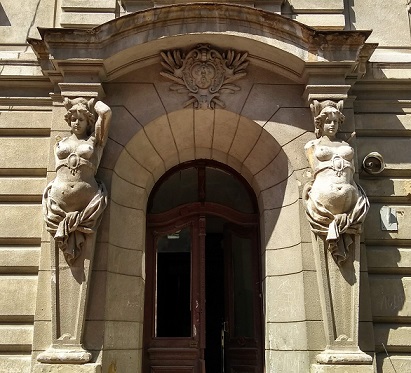
Ceramic tiles
[ Укр: плитка, кахлі ]
A thin object manufactured from ceramic, usually square or rectangular in shape, generally used for covering floors, walls, or other objects.
In the second half of the nineteenth century, ceramic tiles started to be widely used in Lviv to cover the floors and walls of public spaces in buildings.
Floor tiles
More examples of floor tiles here
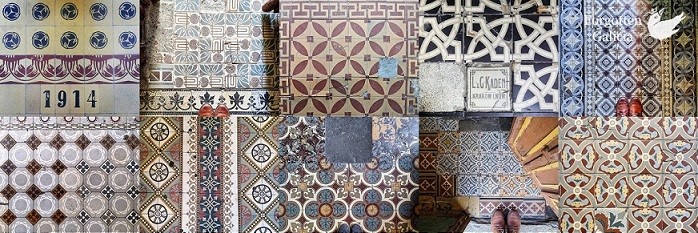
Glazed wall tiles
More examples of wall tiles here
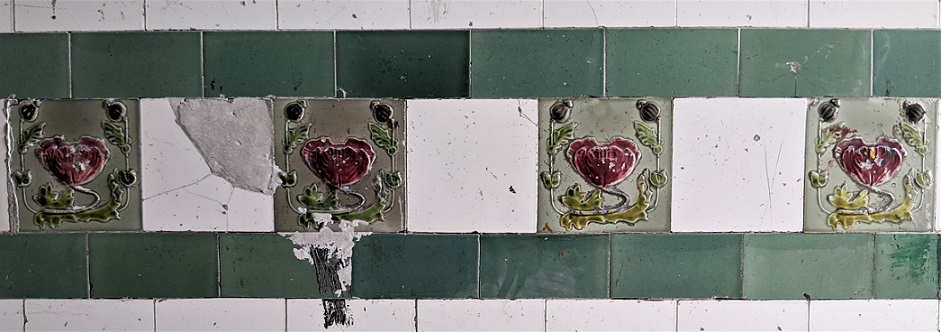
Coal elevator
[ вантажний ліфт ]
A manually operated coal elevator used to hoist coal up to each level of a building, most often found in a courtyard, less often inside a stairwell.
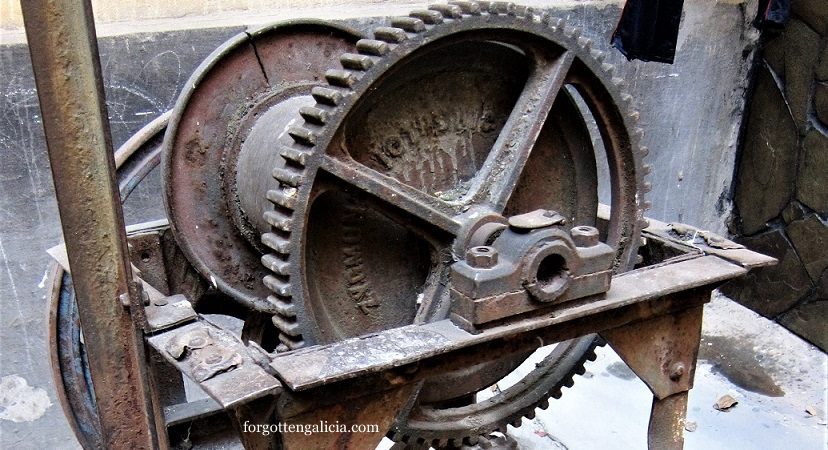
Coal tracks
Tracks that carried wagons of coal or other goods through a building’s carriage entrance to the courtyard.

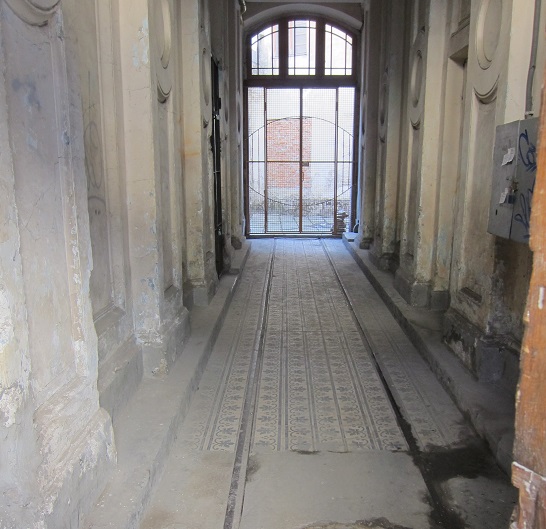
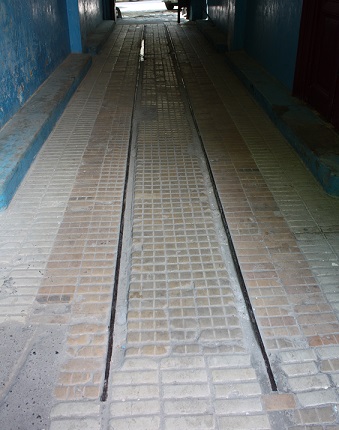
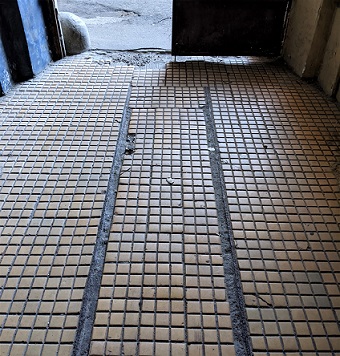
Coat of arms of Galicia
The coat of arms of Galicia and Lodomeria as an element of architecture. Found especially on savings bank, but also on other public buildings across Galicia.
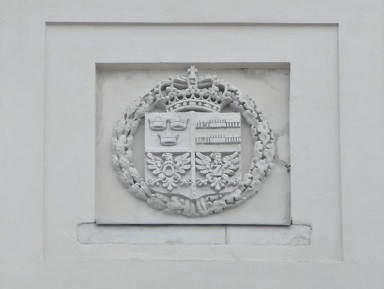
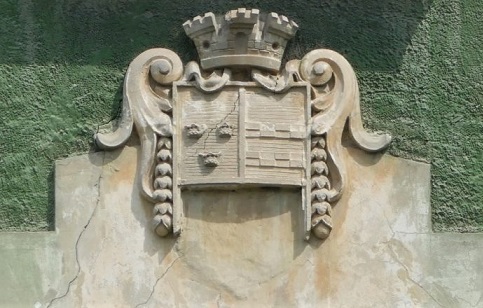
Coat hanger
A decorative metal piece with hooks used as a hanger. Typically found on the railings of galleries or balconies inside a courtyard. Historically, they served for drying, brushing, and airing out coats. Another theory suggests they may have been used for hanging plants or flowers.


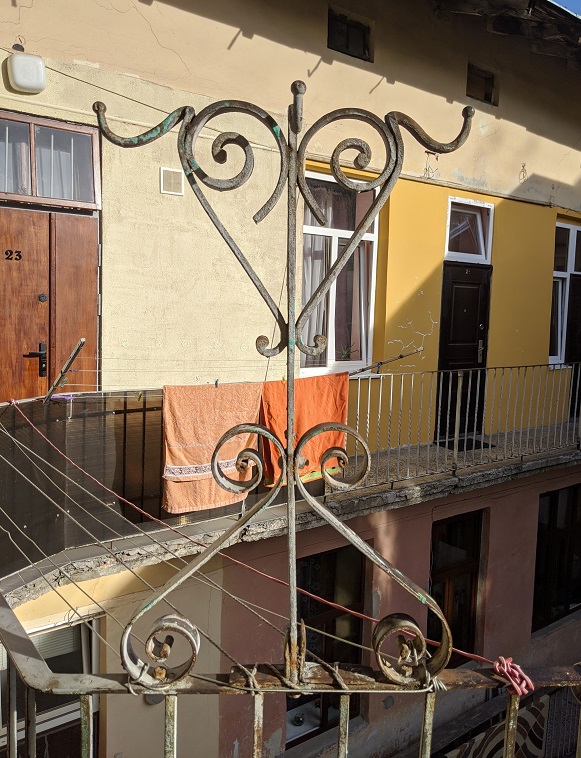

Communal sink
Alternative name: Bassena
A communal water tap with an enamel sink located in a courtyard, hallway, or gallery of a building to supply water to the residents.
Similar sinks can be found in Vienna, where it is called a bassena. In the past, a popular meeting point for the floor’s housewives, cooks, and servants, giving rise to the term Bassenatratsch (Bassena gossip), referring to unreliable rumors.




Conscription number
[ Укр: конскрипційний номер ]
[ Pol: No. konskrypcyjny L.K. or Liczba konskrypcyjną ]
A number assigned to a house, which was also used in birth records so that military officials could examine the transcripts in the bishop’s office and calculate the age of everyone in a particular house. Replaced in 1871 by sequential house numbering and official street names, but still used by builders and in official real estate documentation through the 1930s.
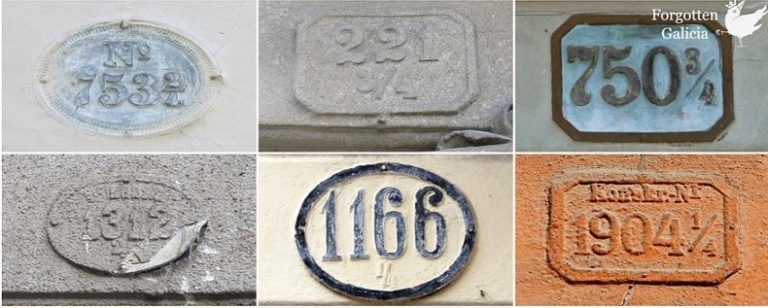
Cornice
[ Укр: карниз ]
Any horizontal decorative molding that crowns a building or furniture element.
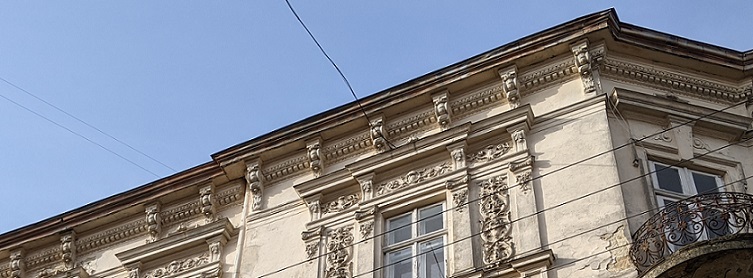
Egg-and-dart
[ Укр: іонік (ови, волові очі) ]
Alternative names: egg-and-tongue, egg and anchor, or egg and star
A decorative molding used in architecture consisting of an egg-shaped form alternating with a V-shaped element (e.g., an arrow, anchor, dart, or tongue).
Found in ancient Greek architecture, used later by the Romans and continues to adorn capitals of modern buildings built in Classical styles. The moulding design element continues in use in Neoclassical architecture.

Electrical panel
[ Укр: електророзподілювач ]
A cast iron construction mounted in a vestibule of a residential building, typically on the left-hand side in a niche in the wall, which distributed the electrical power feed into subsidiary circuits and provided a protective fuse.
In Lviv, produced by Siemens-Schuckert and Siemens & Halske. Today, many of these, especially the ones installed from 1909 to WWI, are still in use.
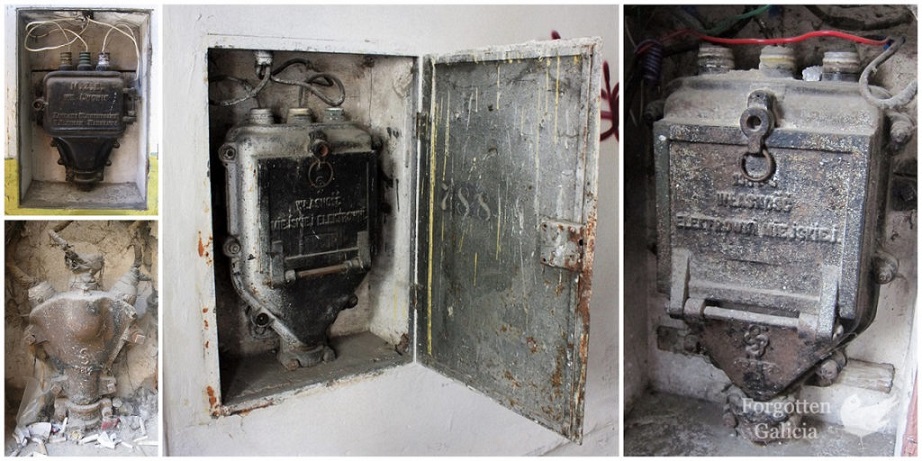
Electrical substation booth
An electrical transformer substation located in a metal booth, the design of which was made in 1908. Starting in 1909, electricity was channeled from the new electric power station in Lviv to the three central distribution points, to which 72 transformer substations were connected, 40 of which were located in special transformation booths. From the booths electricity was supplied to consumers via electrical panels.
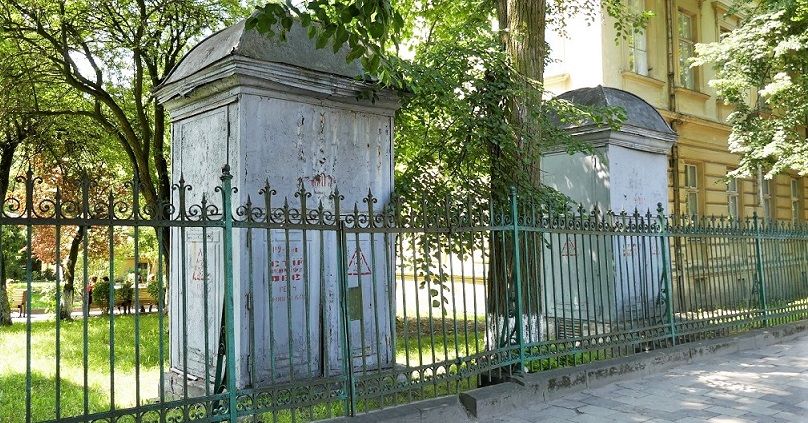
Festoon
[ Укр: фестон, гірлянда ]
Alternative names: garland or swag
A wreath or garland hanging from two points, and in architecture typically a carved ornament depicting conventional arrangement of flowers, foliage, or fruit bound together and suspended by ribbons.
In Lviv, commonly found in Neoclassical and Secessionist architecture.
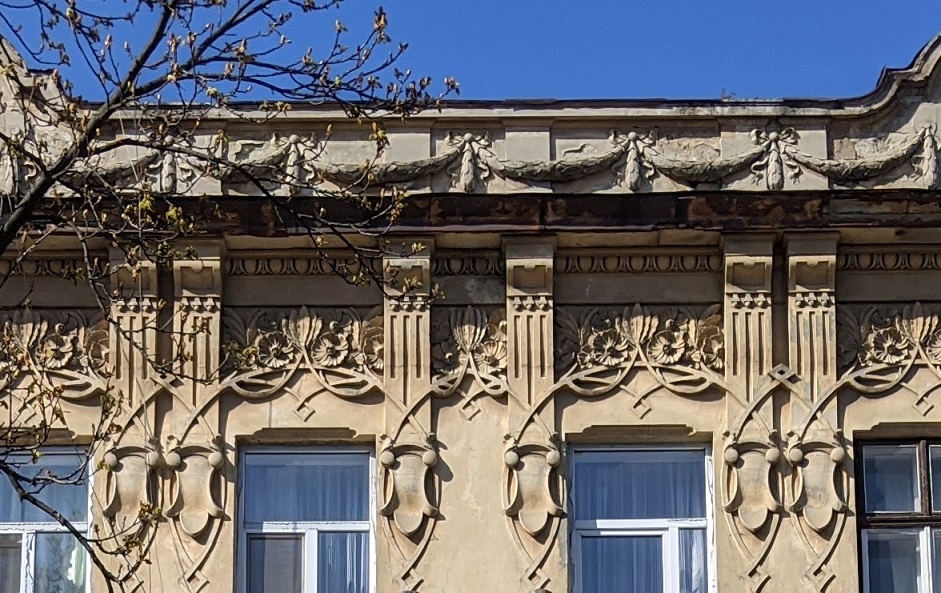

Finial
A distinctive ornament at the apex of a roof, pinnacle, canopy, or similar structure in a building; a decorative fitting at the peak of a gable, or on the top of a flagpole, fence post, or staircase newel post.

Frieze
[ Укр: фриз ]
Any long, narrow, horizontal panel or band used for decorative purposes on the exterior walls of buildings or on the walls of a room.

Mural
[ Укр: розпис ]
Mural paintings commonly found on ceilings and walls.
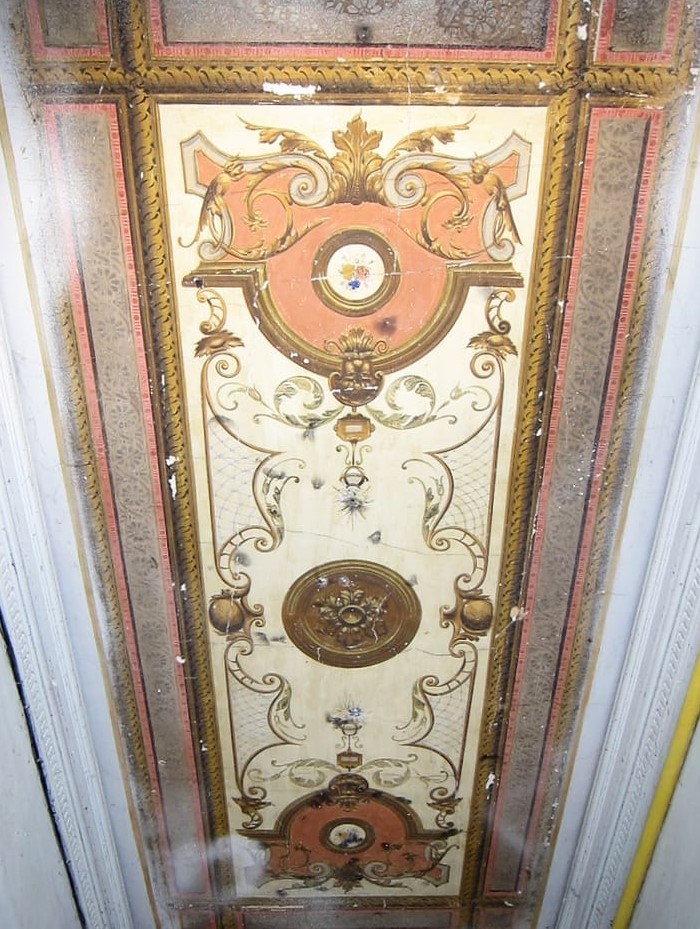
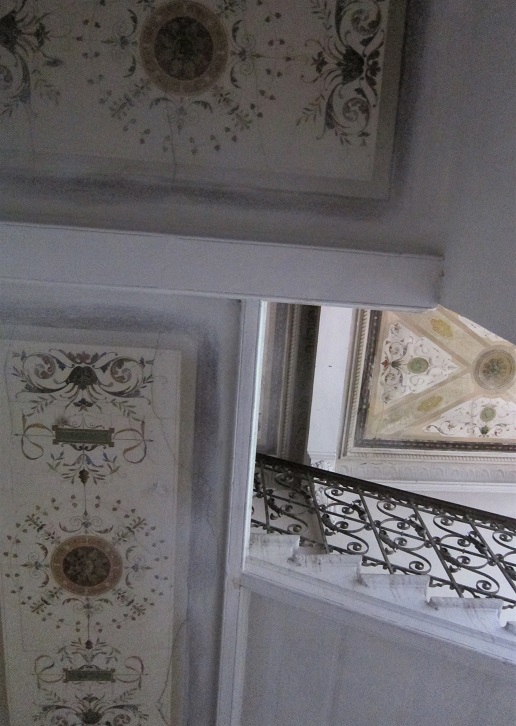
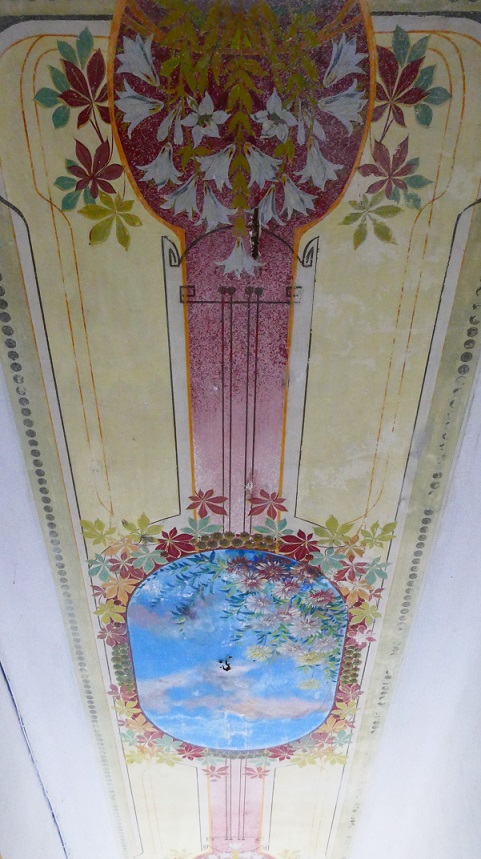

Gable
[ Укр: щипець ]
The triangular portion of a wall between the edges of intersecting roof pitches.
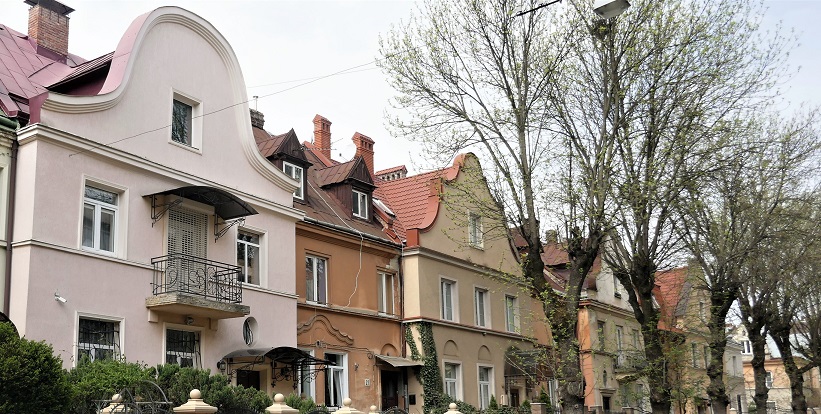
A Dutch gable (or Flemish gable) is a gable end whose sides have a shape made up of one or more curves, often terminating in volutes, and topped with a pediment.
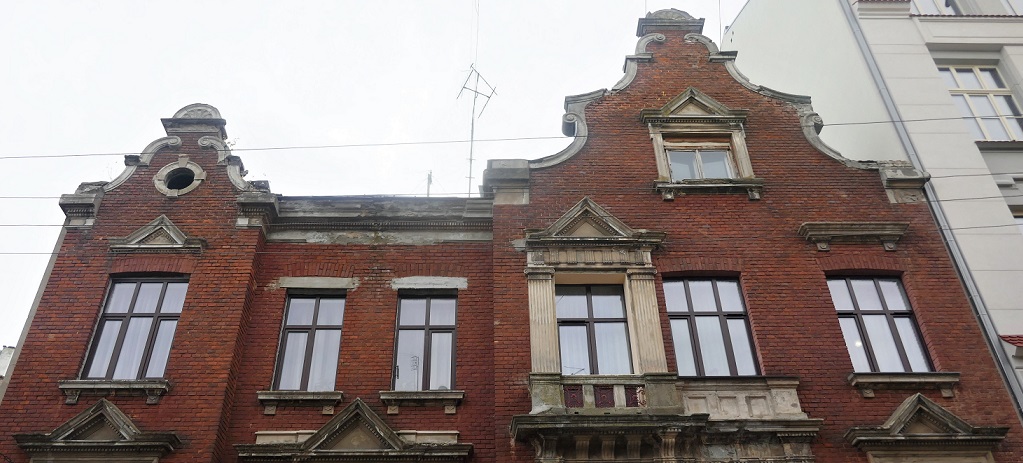
Gallery
[ Укр: галерея ]
A narrow balcony or platform running the length of a wall.
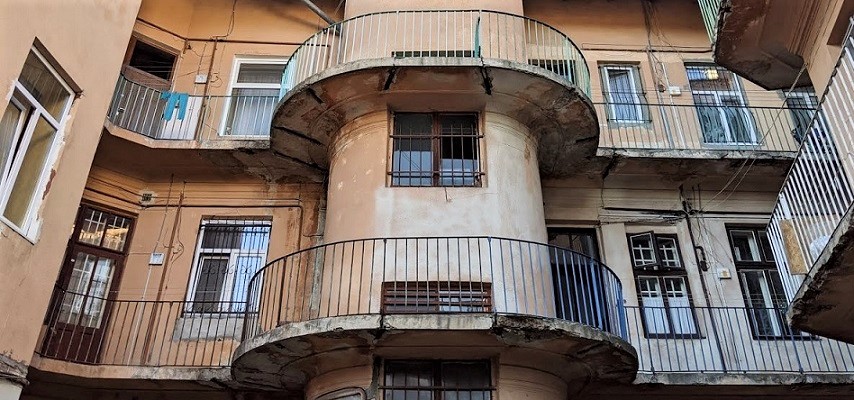
Ghost sign
[ Укр: написи-привиди ]
Alternative names: fading ads or brick ads
An old hand-painted sign that has been preserved on a building for an extended period of time and that often advertises products, brands, or businesses that no longer exist.
In Galicia, ghost signs are in Polish, Yiddish, German, and Ukrainian—the four main languages spoken in the region before the war. The signs were often painted on the front of stores to advertise what products were for sale.
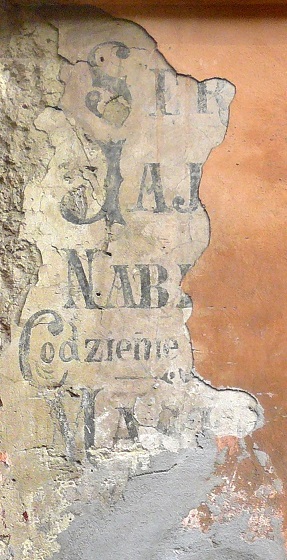
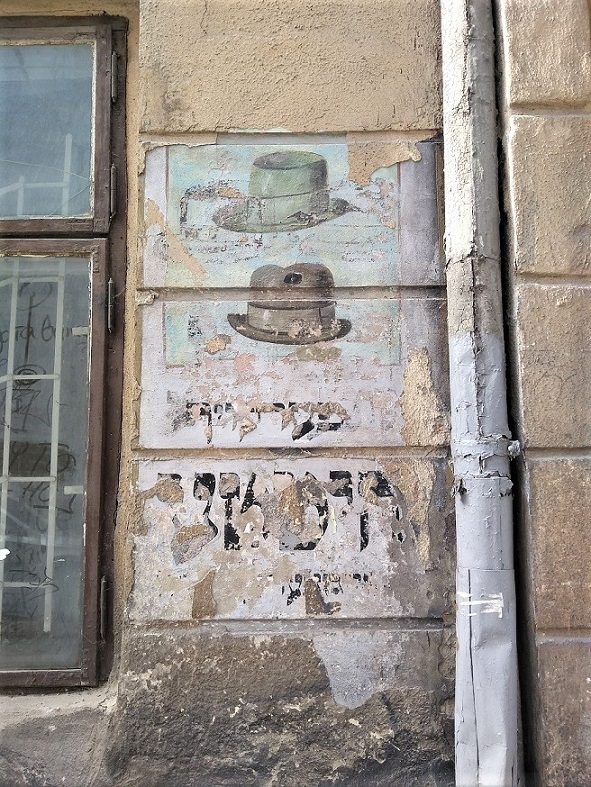
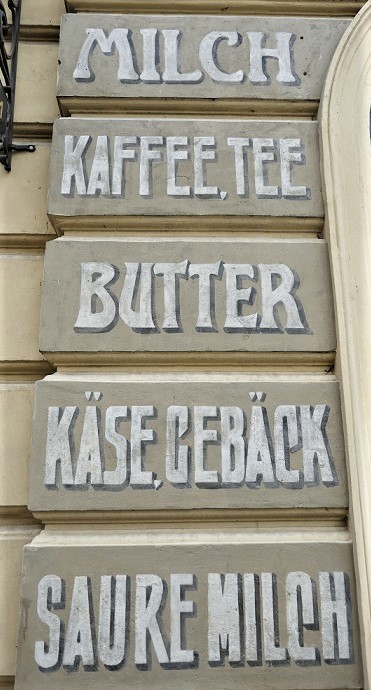
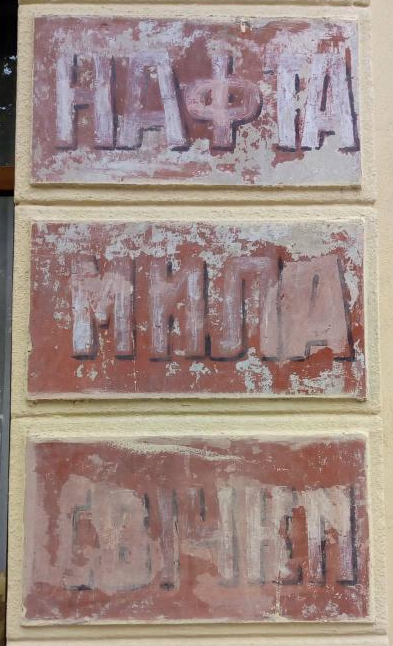
Greek fret
Alternative names: the Greek key or key pattern, a meander
A decorative border constructed from a continuous line, shaped into a repeated motif. Сommon decorative elements in Greek and Roman art. In ancient Greece they appear in many architectural friezes.
Found in classical Greek and Roman architecture and derivatives.
In Lviv, found especially in Neoclassicism, but also in Historicism.

Guard stone
[ Укр: обмежник, відбійник ]
An exterior architectural element made of metal, stone, or concrete located at the corners of an entryway, carriage driveway, or gateway to protect walls from carriage wheel damage.
In Lviv, found all around the city’s historical districts. The most common are small curved metal posts, but stone and concrete ones can also be found.

Guttae
[ Укр: гута ]
Originally a small water-repelling, cone-shaped projection used near the top of the architrave of the Doric order in classical architecture. Renaissance and later architecture these strict conventions are sometimes abandoned, and guttae and triglyphs, alone or together, may be used somewhat randomly as ornaments. In Renaissance, guttae are often stylized in the shape of a pyramid.
In Lviv, found especially in Baroque, Neo-Baroque, and Secession.
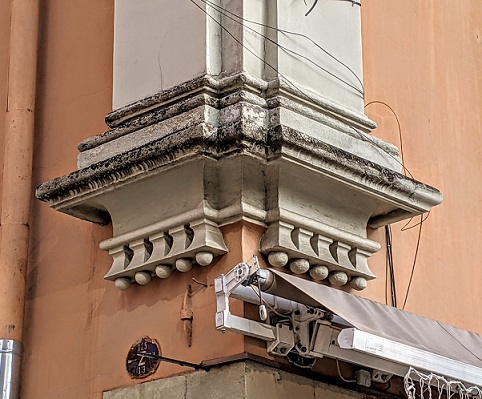

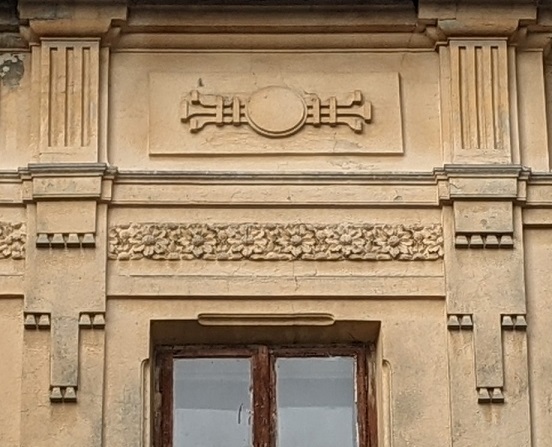
Hand pump
A hand-powered water pump, once commonly installed over community water wells.

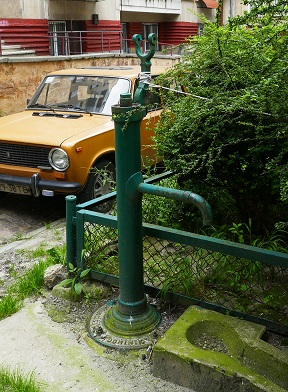


Keystone
Also known as a capstone, the wedge-shaped stone at the apex of a masonry arch.
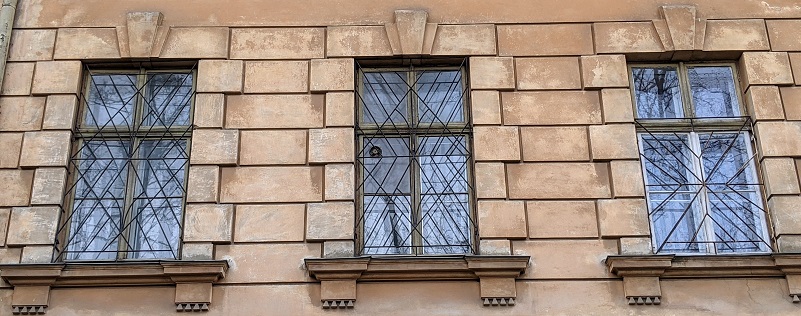
Lincrusta
[ Укр: лінкруста ]
A deeply embossed wallcovering. Lincrusta was launched in 1877 and was used in a host of applications from royal homes to railway carriages.

Majolica
Earthenware coated with opaque white tin glaze. In architecture, majolica generally refers to weather-proof, ceramic tiles with such a glaze.
In Lviv, used especially in Secession architecture. A favorite of architect Ivan Levynskyi’s who called majolica his “lover.”
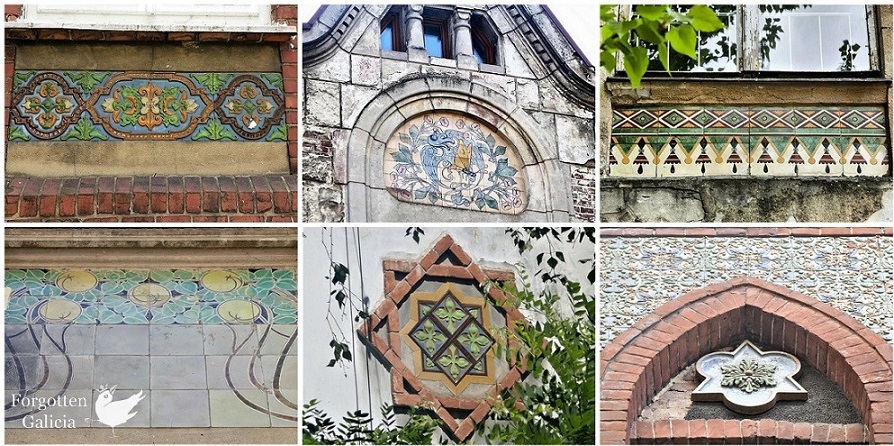
Manufacturer’s mark
The name of the manufacturing firm (or supplier or installer), often including the name of the city of the company’s location or branch. embossed, carved, painted, stamped, etc., on to building material, an element of architecture, etc.
The mark serves as a stamp of quality and as an ad.
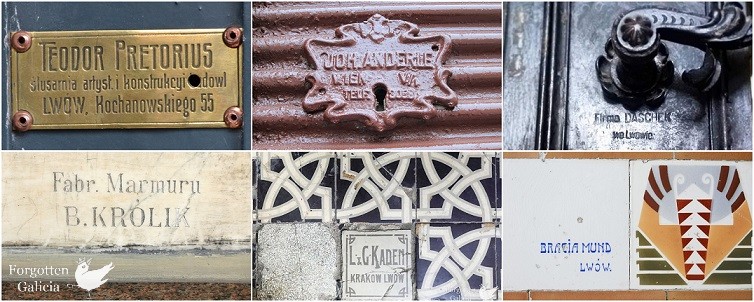
Marker plate
A small metal plate attached to the façade of a building indicating the location of a nearby hydrant or valve.

Mascaron
[ Укр: маскарон ]
An ornament in the shape of a face, usually human, sometimes frightening or chimeric whose alleged function was originally to frighten away evil spirits so that they would not enter the building. The concept was subsequently adapted to become a purely decorative element.
In Lviv and Galicia, Secession architecture extensively employs mascarons.
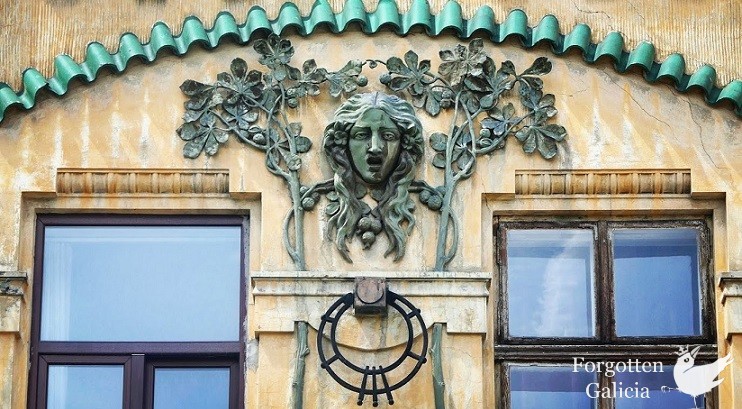
Masonry heater
[ Укр: піч, п’єц ]
[ Pol: piec ]
Alternative names: masonry stoves, cocklestoves (also tile stoves or ceramic stoves)
A device for warming an interior space through radiant heating, by capturing the heat from periodic burning of fuel, and then radiating the heat at a fairly constant temperature for a long period.
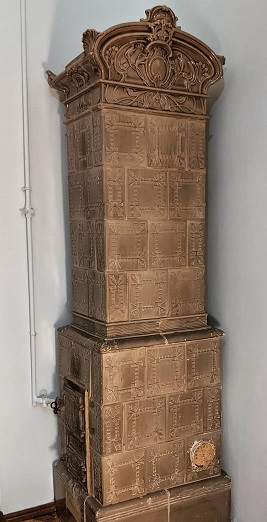
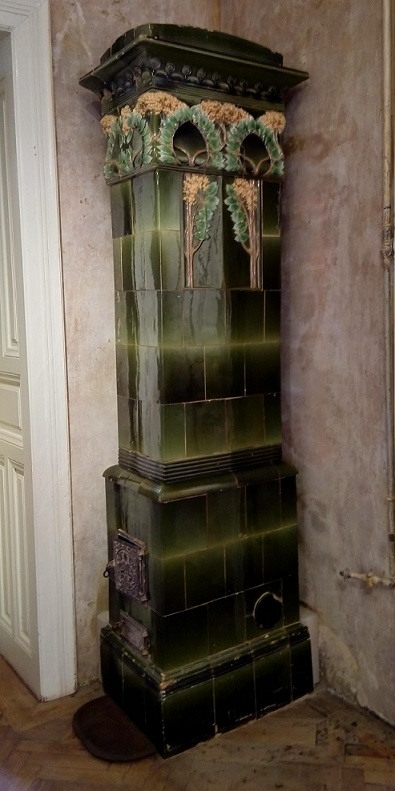
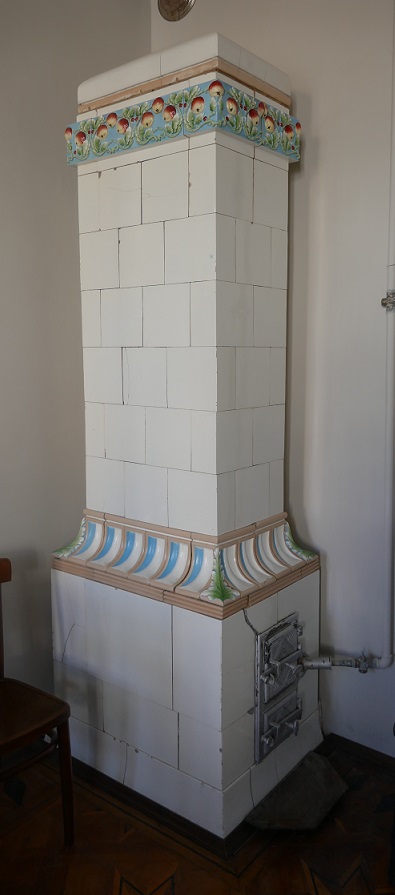
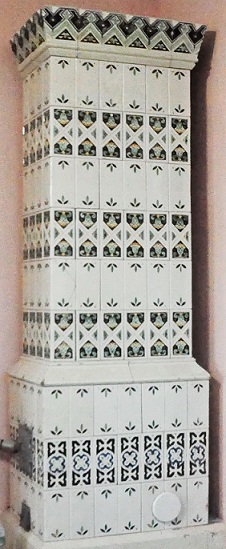
Mezuzua slot
A slot in the doorframe used to hold a mezuzah—a piece of parchment contained in a decorative case inscribed with specific Hebrew verses from the Torah. When passing through the doorpost, an observant Jew touches the mezuzah to show respect to God and to be reminded to live a spiritual or religious life.
In Lviv and Galicia, several such slots survived, but today they no longer serve as place for mezuzahs, but rather as reminders of the people who used to reside on these streets.


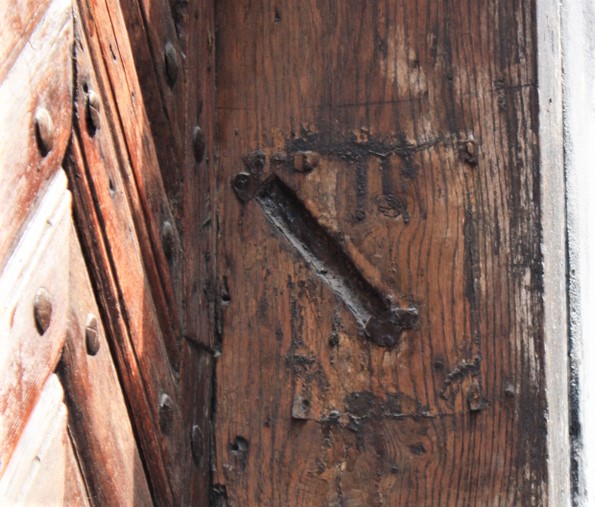

Modernist flagpole
A mast-like flagpole adorning the top of a modernist edifice, inspired by early twentieth-century ocean liners.
One of the characteristic features in Polish functionalist (modernist) architecture (1918-1939).

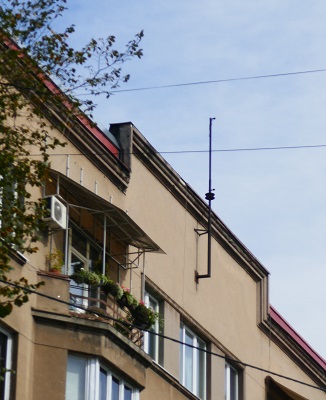
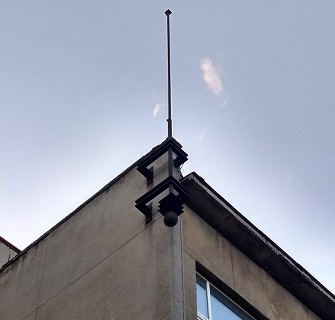
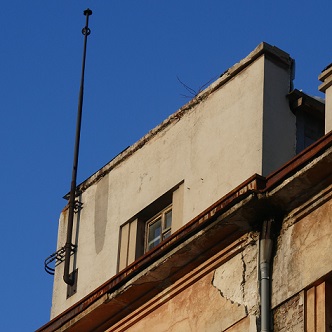
Newel post
A post supporting one end of a handrail at the top or bottom of a flight of stairs.
A newel post lamp is newel post, due to its prime location, that also functions as a lamp post. Early newel posts burned oil or paraffin, but eventually were replaced by gas lighting. And ultimately, with the onset of electricity, electric wires replaced the gas supply tubes to bring electric light to the spaces.
In Lviv, most newel post lamps date from the late 19th-early 20th centuries and originally burned gas.


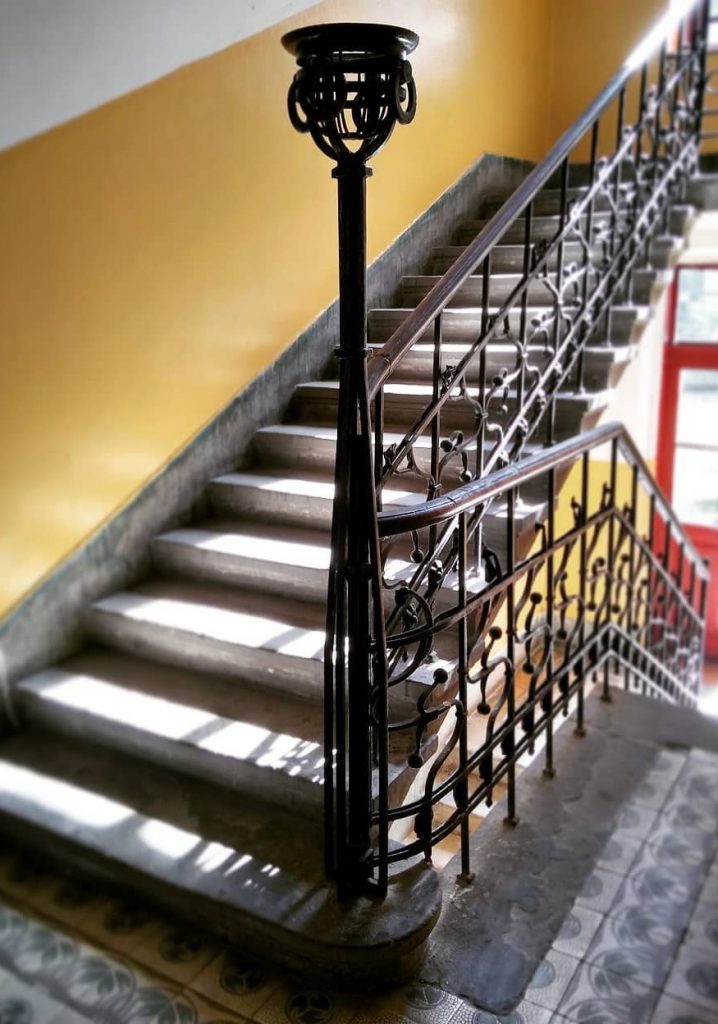

Niche
[ Укр: ніша ]
А decorative recess set into a wall for the purpose of displaying a statue, vase, font, or other object.
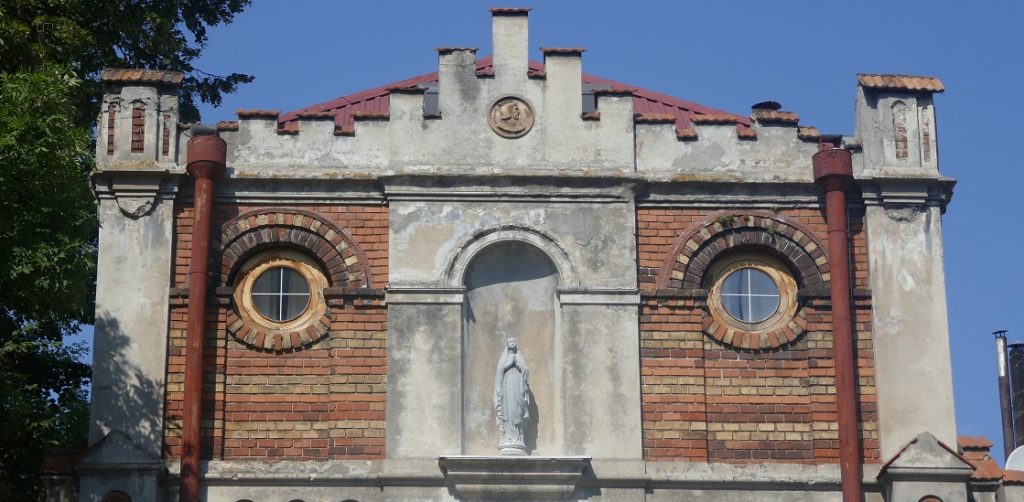
A “ghost statue” — my term for an empty niche found on the facade of a building where once stood a statue, typically a religious figure such as the Virgin Mary or a saint. Under the Soviet Union, traces of religion were removed from the urban landscape, and as a result, all around Lviv one can find niches with pedestals or mounting elements, but with no statues.
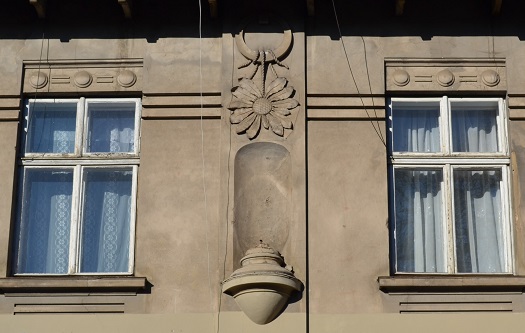
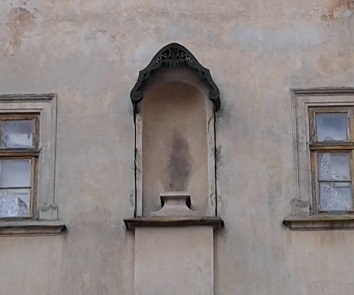
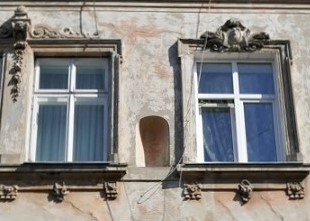
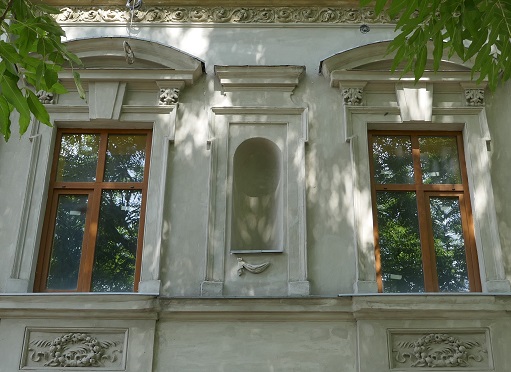
Overdoor
[ Укр: десюдепoрт (фр. dessus-de-porte), супрапорт ]
Alternative names: supraporte (from German) or a sopraporte (from Italian)
An ornamental painting, carving, or section of woodwork directly above a doorway.
In Lviv, found especially on interior doorframes of Historicism and Secession buildings.

Pediment
A small ornamental gable, usually triangular, above a door, window, or niche. Most common variations are pointed, curved, and broken.
In Lviv, found in Classicism and Renaissance (pointed and curved), Baroque (especially broken), and Historicism.
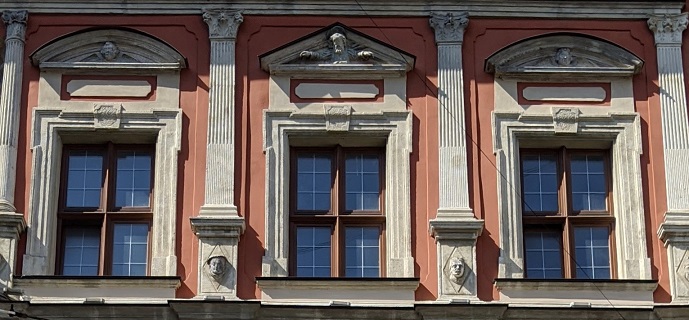
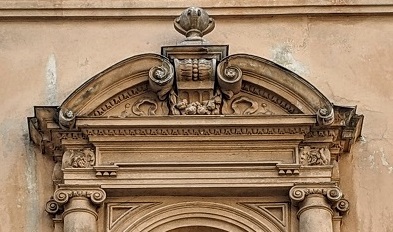
Pilaster
[ Укр: пілястра ]
An architectural element in classical architecture used to give the appearance of a supporting column and to articulate an extent of wall, with only an ornamental function.
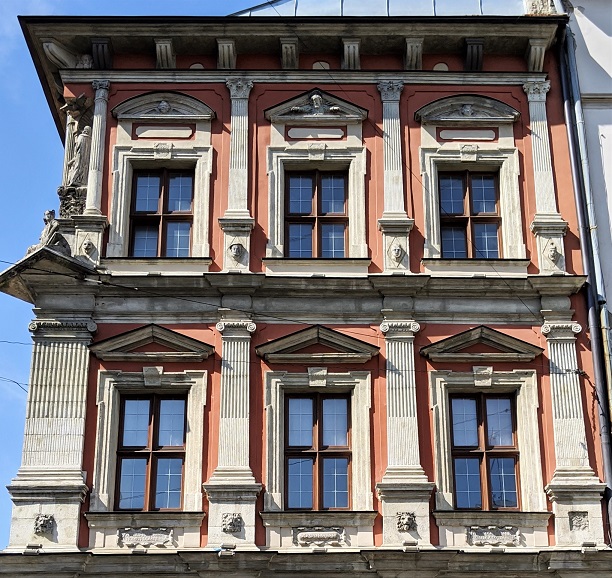
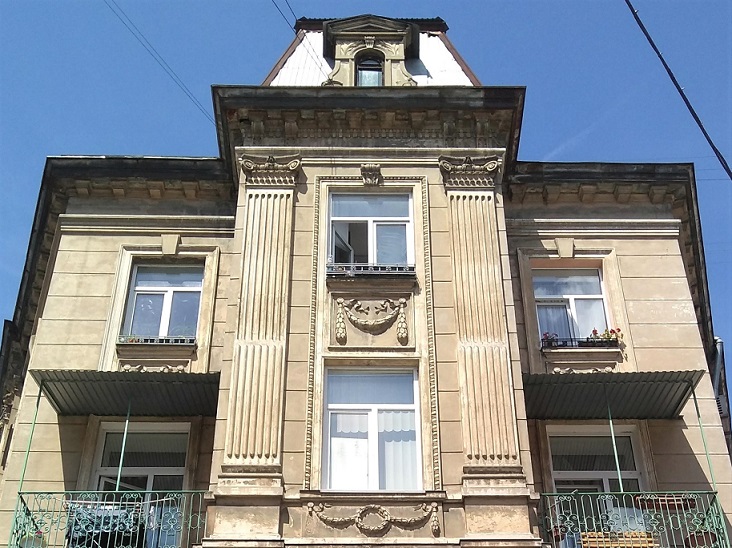
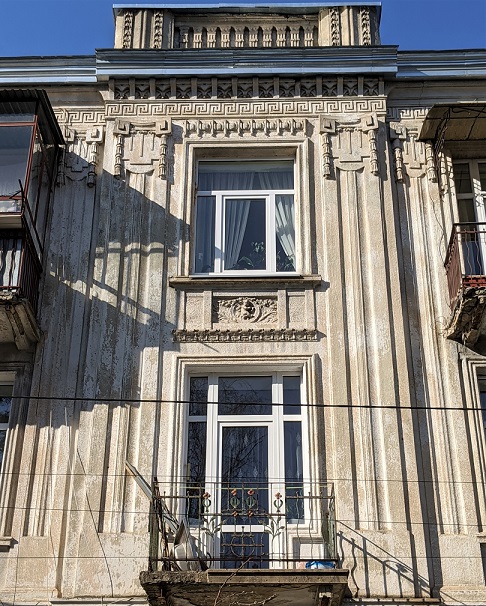
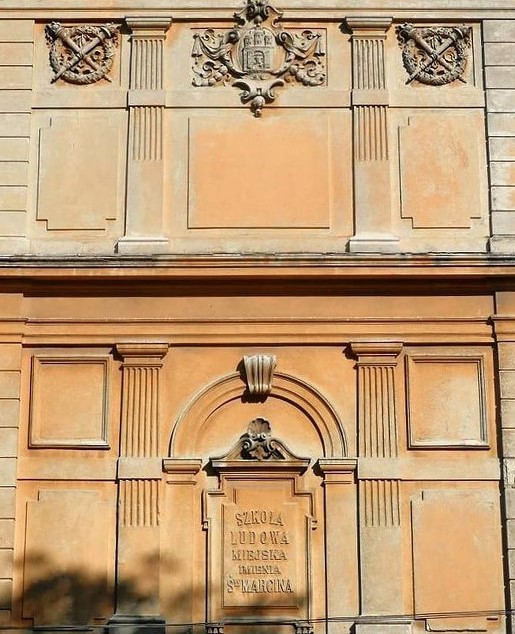
An example of layered pilasters

Polish roof
А high, two-level hipped roof. Originally found in manor houses of the Polish nobility, but also a typical feature in Polish Manor Style architecture (styl dworkowy) of the early twentieth century.
In Lviv, entire neighborhoods of Polish Manor Style architecture were built.
Examples can be found here and here
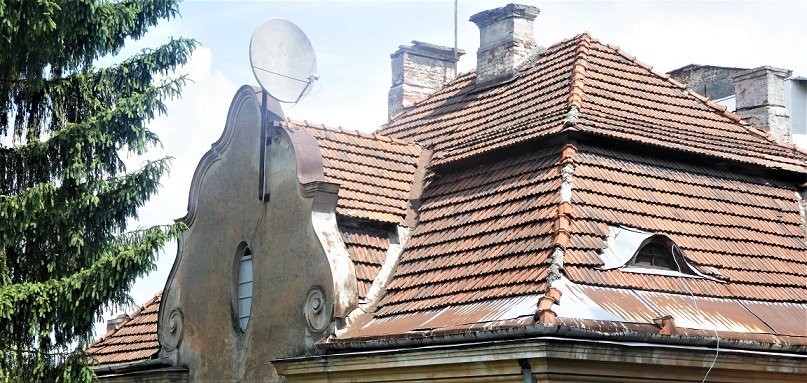
Porte-cochère
A large covered entrance for coaches leading into a courtyard.
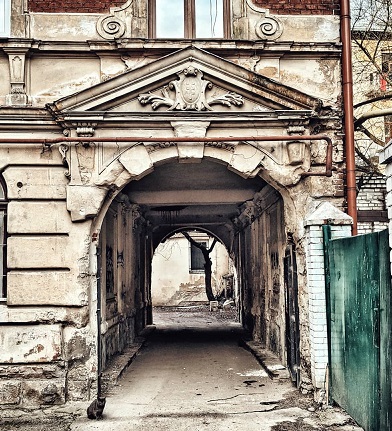
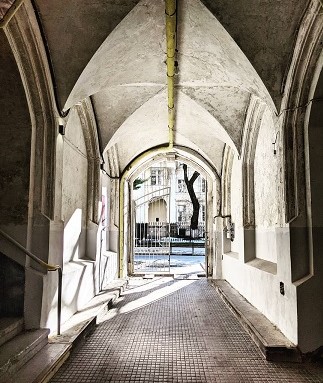
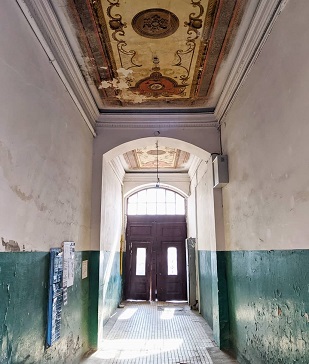
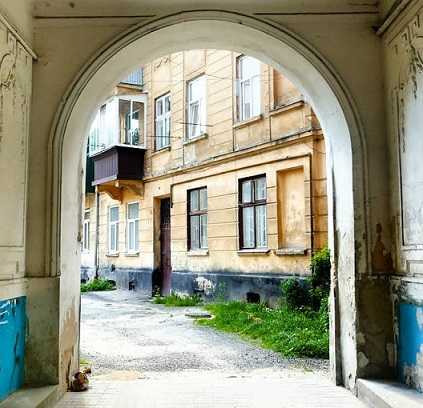
Porthole
[ Укр: ілюмінатор ]
A circular “porthole” window, inspired by the porthole in ocean liners, a common design element in Art Moderne (Streamline style).
One of the characteristic features in Polish functionalist (modernist) architecture (1918-1939).
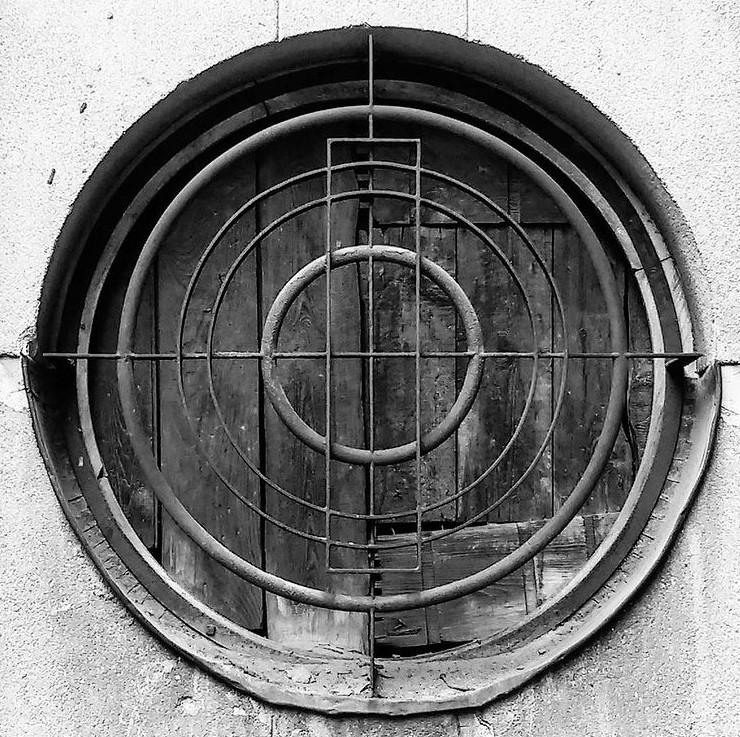

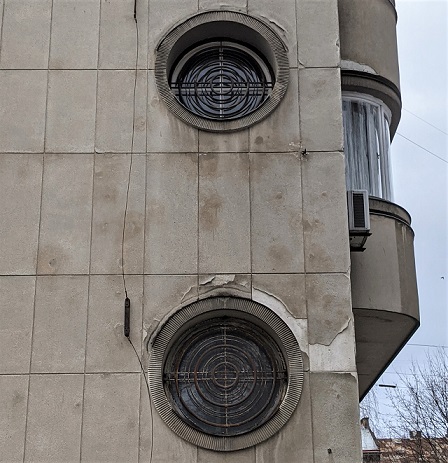
Portico
A small porch composed of a roof supported by columns, often found in front of a doorway.

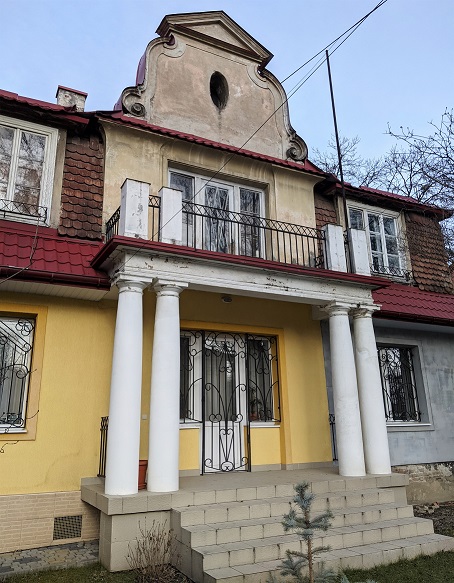

Quoins
Masonry blocks at the corner of a wall. Some are structural, providing strength for a wall made with inferior stone or rubble, while others merely add aesthetic detail to a corner.
Similar treatment was used around wall openings (windows, doorways, and arches).
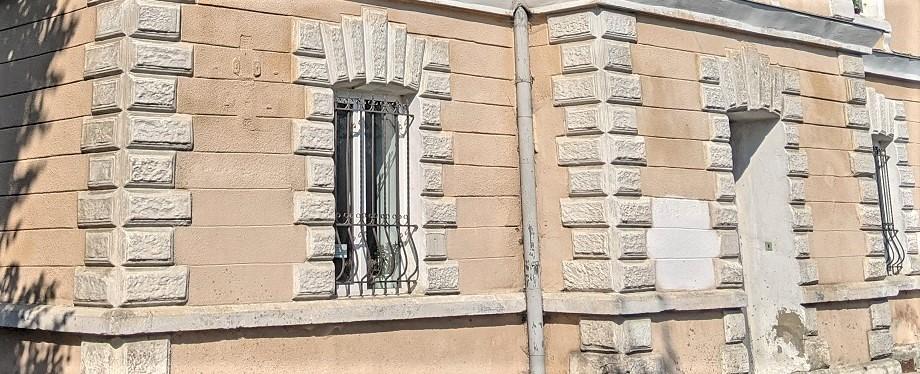
Radiant sun motif
A frequent motif of the Zakopane Style architecture taken from Górale vernacular architecture. Typically found on a gable as a rising sun or a sun with long thin rays.

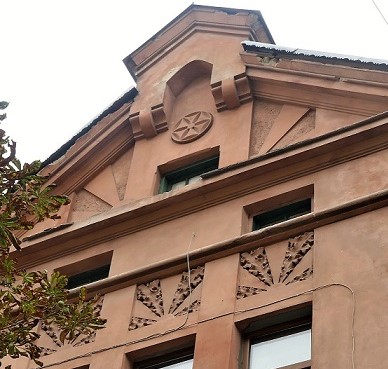
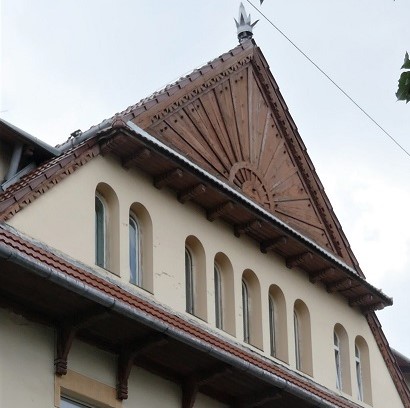
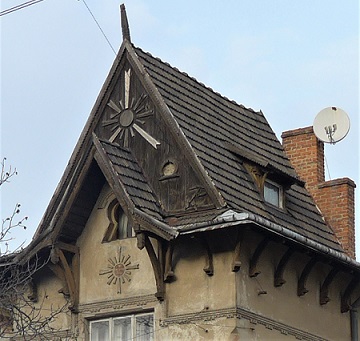
Recessed portal
[ Укр: перспективний портал ]
Alternative name: stepped portal
A portal that is recessed into the wall with a series of stepped planes, allowing the recession to be incremental.
Originally found in Romanesque and Gothic church portals, which have multiple set-back arches resting on a series of jambs.
In Lviv, found in Art Deco and Functionalism.

Relief
[ Укр: рельєф, барельєф ]
A sculptural technique where the sculpted elements remain attached to a solid background of the same material. There are three classifications depending on how much the figures project from the background: low or bas-relief, mid relief, and high relief.
In Lviv, mid and bas-reliefs found especially in Empire Style (Classicism) architecture.
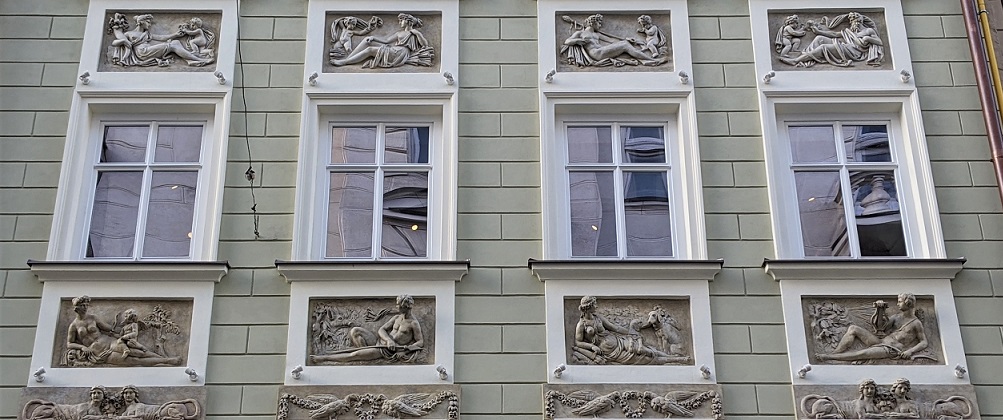
Roller shutter
A type of door or window shutter consisting of many horizontal slats (or sometimes bars or web systems) hinged together. The door is raised to open it and lowered to close it. It provides protection against wind, rain, fire, and theft.
The locks of roller shutters were often embossed with the manufacturer’s mark.
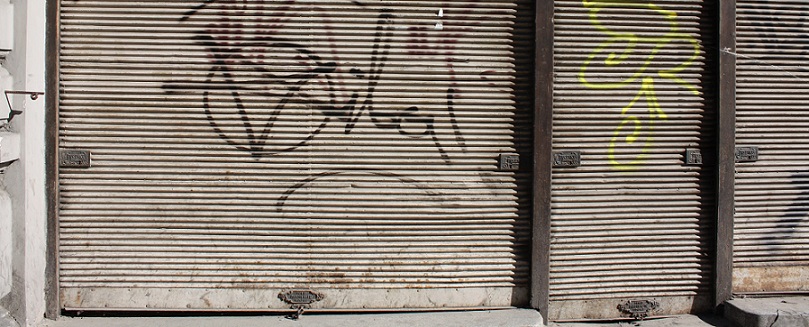
Rosette
A round floral ornament, usually carved or painted.
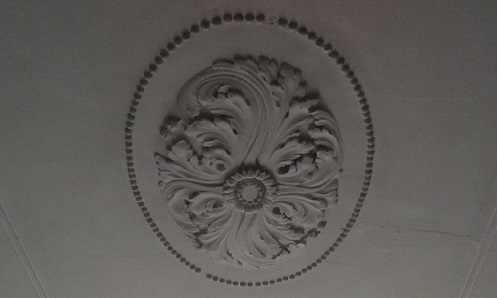
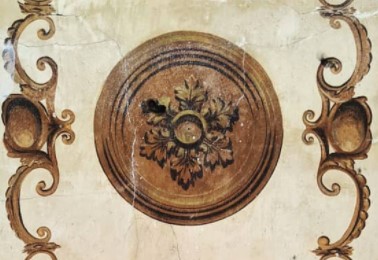
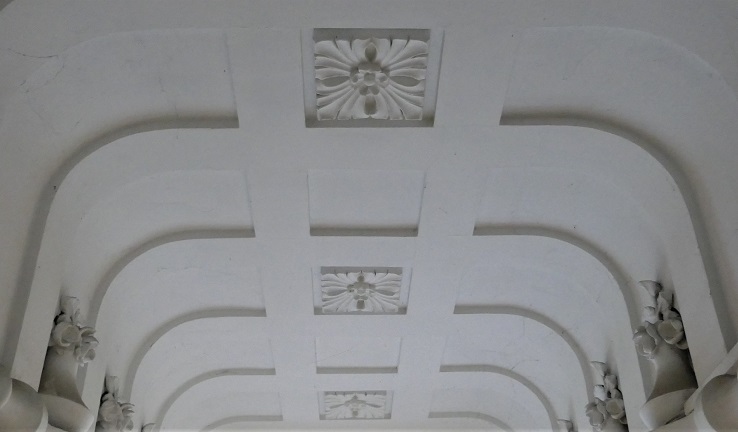
Rustication
[ Укр: рустування ]
A range of masonry techniques used in classical architecture giving visible surfaces a finish texture.
Especially popular in the revived classical styles of Italian Renaissance architecture.
In Lviv, found in Renaissance, Historicism (especially, neo-Renaissance).

Sgraffito
[ Укр: сграфіто ]
A technique either of wall décor, produced by applying layers of plaster tinted in contrasting colors to a moistened surface and then scratching so as to reveal parts of the underlying layer.
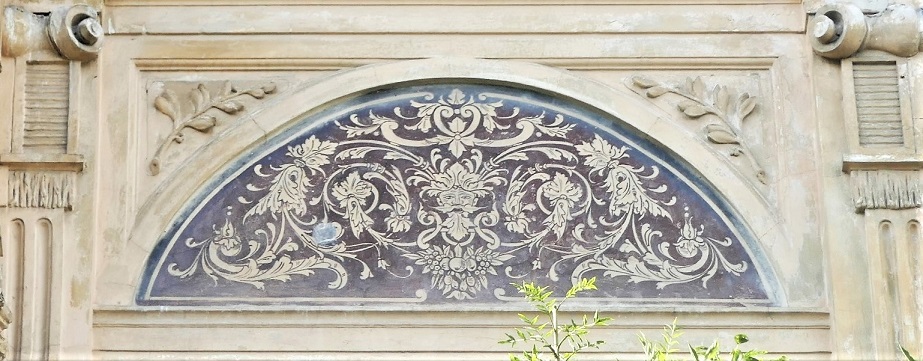
Six-petal rosette
[ Укр: знак Перуна, громовий знак, гуцулська розетка, бойківська розетка ]
[ Pol: rozeta karpacka, rozeta podhalańska, rozeta góralska]
Alternative names: hexafoil, flower of life (New Age name for expanded rosette)
A flower-like symbol created by overlapping seven circles. An ancient symbol that has been used across cultures and religions for millennia.
The rosette is a solar symbol in many cultures and many peoples believed it to be magical. It was commonly used as a decorative motif to adorn doors, ceiling beams, crosses, cornices, coats of arms, everyday objects, furniture, musical instruments, ritual items, graves.
In Galicia, found on Renaissance ceiling beams and the beams of cottages in the Carpathians, as well as on everyday folk objects, furniture, musical instruments, ritual items, graves, etc.
In Galicia and Lviv, commonly used as symbol in Hutsul Secession and the Zakopane Style.
Examples on crossbeams across Galicia
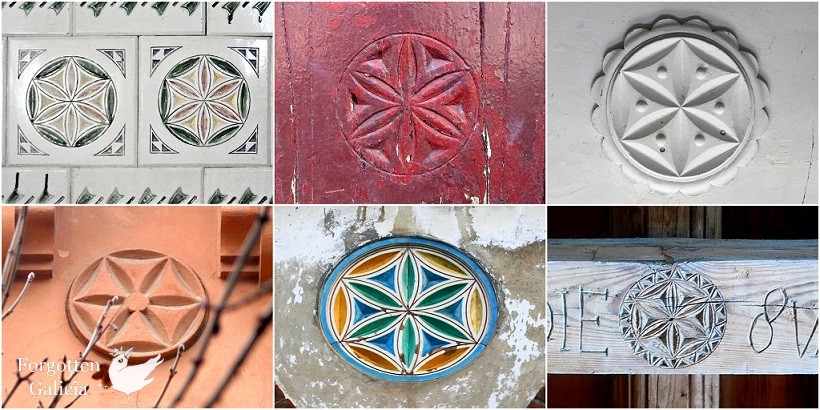
Skylight
[ Укр: світловий ліхтар ]
Sometimes called a rooflight, a light-transmitting structure that forms all or part of the roof space of a building for daylighting purposes.
A lightwell is an unroofed external space provided within the volume of a large building to allow light and air to reach what would otherwise be a dark or unventilated area.
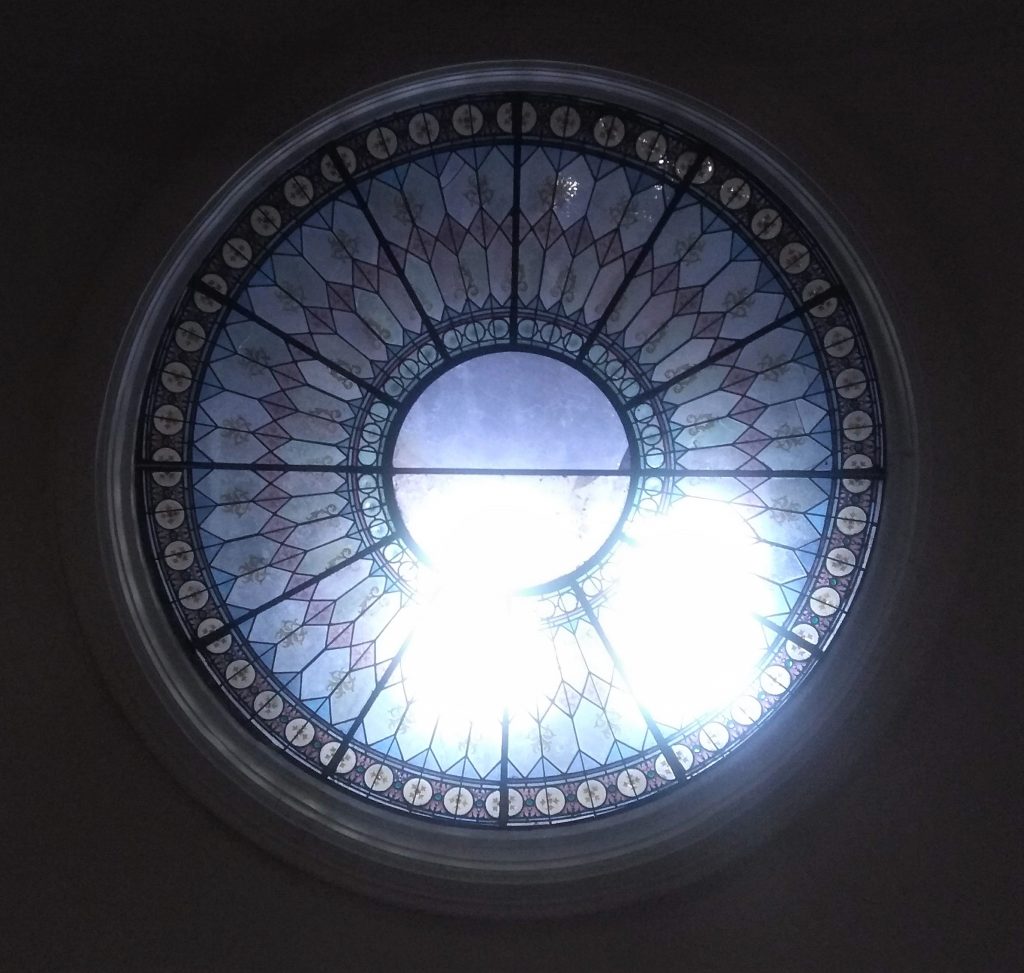

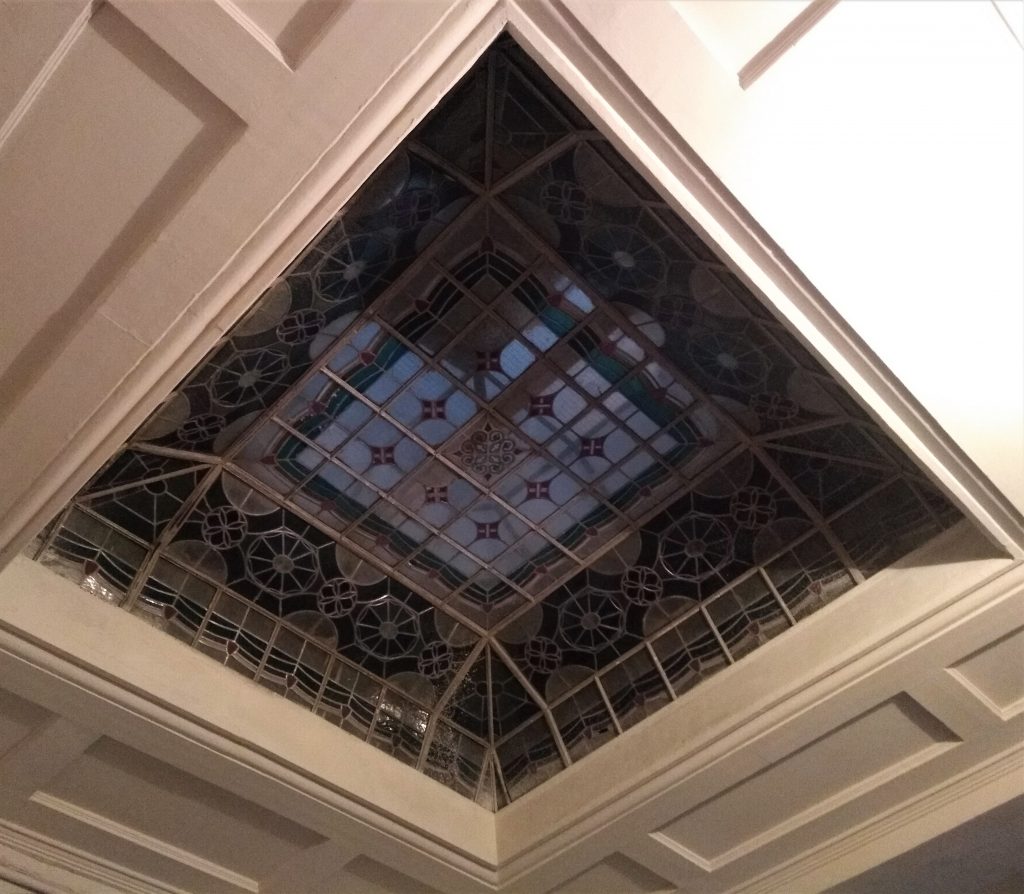
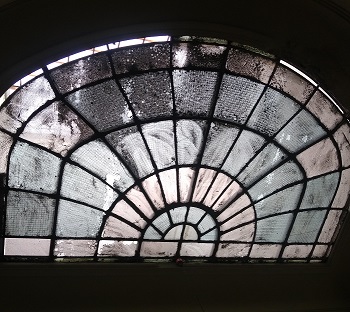
Street sign plaques
In 1871 sequential numbering and official street names were introduced in Lviv, and as part of the new numbering system, plaques, which included both the street name and building number, were attached to the facades of each building. These plaques were either rectangular or oval, and generally white with a colored frame that indicated a specific district.
A few examples of these still remain in Lviv — today displaying street names which have long been renamed.

Terrazzo
A composite material, poured in place or precast, which is used for floor and wall treatments. It consists of chips of marble, quartz, granite, glass, or other suitable material, poured with a cementitious binder (for chemical binding), polymeric (for physical binding), or a combination of both.
In Lviv, found in Historicism, often with ornaments or inscriptions, especially the Latin greeting “Salve” or the Polish variant “Salwe.”
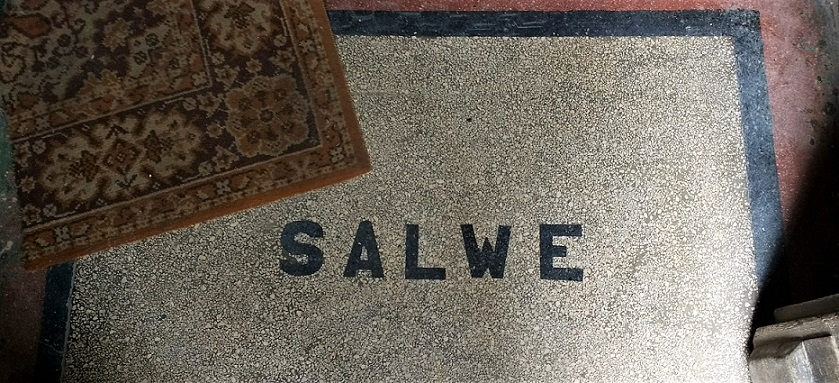
Triglyph
The vertically channeled tablets of the Doric frieze in classical architecture, so called because of the angular channels in them. A panel with three vertical lines, and represent the wooden beams used in prehistoric buildings to support the roof.
Found in classical Greek and Roman architecture and derivatives.
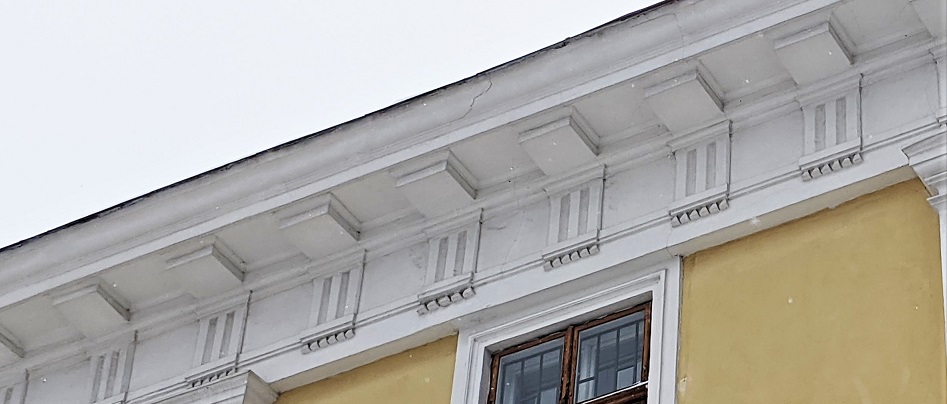
Utility covers
These Austrian- and Polish-era cast iron plates cover buried public utilities and services such as sewers, storm drains, water mains, electricity, telephone, hydrants, etc. Though they continue to serve their original function and prevent unauthorized access, the companies or states that manufactured them are defunct and the language used to convey their manufacturer’s marks has long lost its official status.
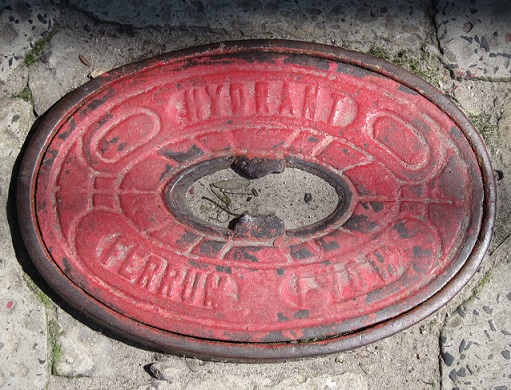

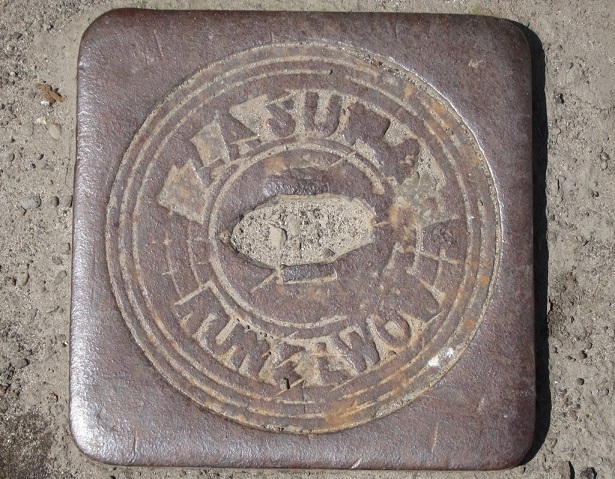
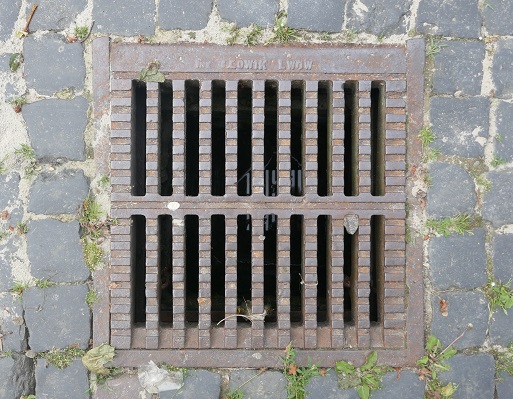
Urine deflector
Alternative name: anti-toilet
A form of hostile architecture, an element of the built environment that prevents people from urinating on the street. cones built into the nooks of buildings, which cause the culprit to be showered with his one pee.

Vacuum inlet
A part of a central vacuum cleaner system installed in a wall inside a building to which a hose can be attached to then remove dust, particles, and small debris from interior rooms and stairwells.
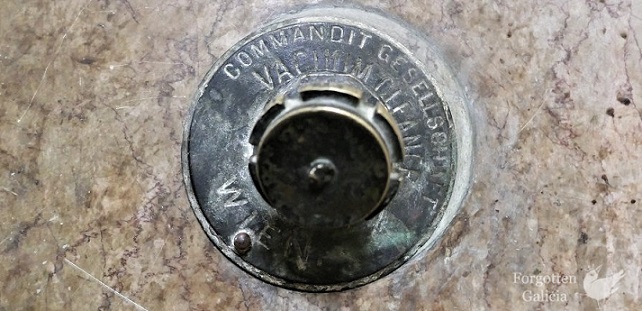
Vault light
A flat-topped walk-on skylight, usually set into a sidewalk or floor to let sunlight into the space below. Prisms were often used used instead of flat glass to disperse the light, diffusing it over a large area and/or to throw it sideways under the building. Vault lights were developed in the 19th century, but declined in popularity with the advent of cheap electric lighting.
In Lviv, many of the examples of vault lights were made by the Luxfer Prism Company (established in 1897 in Chicago).
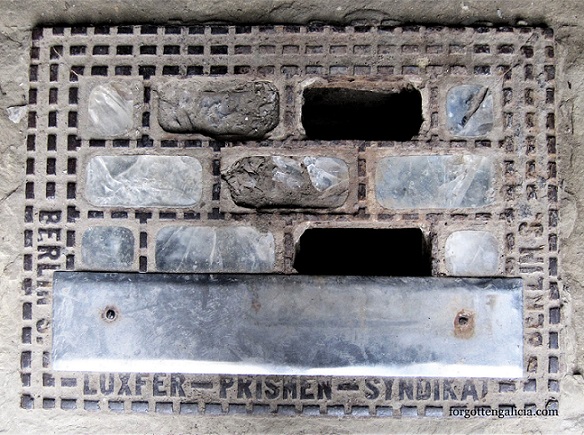

Vault window
[ Укр: підвальна віконечка ]
A small window to the basement, likely were also as chutes to bring goods or coal directly into the basements from the streets.
The metal shutters typically feature a decorative cutout, which would have provided light and ventilation in the basement vaults.
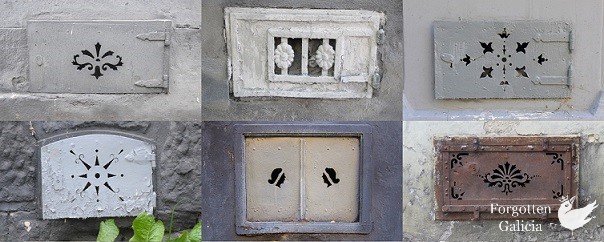
Ventilation window
A small window set into the frieze that runs along the top of the exterior wall of the house used to ventilate attic spaces. In Lviv such windows became standard practice in the second half of the nineteenth century, following the implementation of the city’s building codes in 1855 and 1885.

Volute
[ Укр: волюта ]
The spiral, scroll-like ornament found in the capital of the Ionic column, and which was later used in Corinthian and Composite column capitals.
The volute was used in Renaissance and Baroque architecture, where it can be found as an ornament on various architectural elements from counsels (corbels), columns, pilasters, window pediments, architraves, portals, cartouches, to elements of the interior, such as staircases.
The element was then passed on to other movements, especially revival architecture, but also to Art Nouveau and Art Deco, both of which modernized familiar ancient and classical patterns and ornaments.
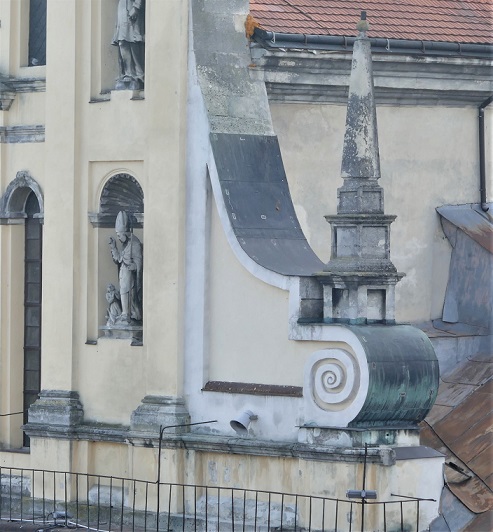
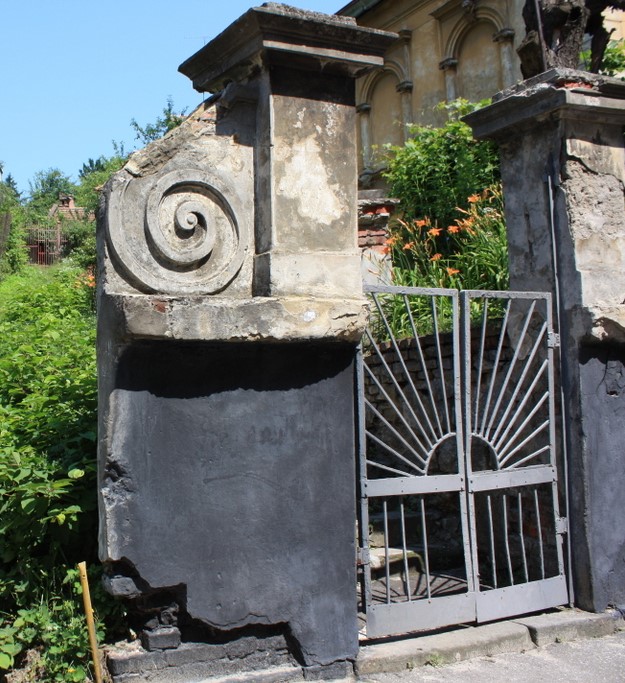


Wagner’s wreath
[ Укр: вінок Вагнера ]
The motif of a circle with three vertical strips found in Secession architecture (inspired by the work of Viennese-architect Otto Wagner). (Term coined by architectural historian from Lviv Tetiana Kazantseva.)

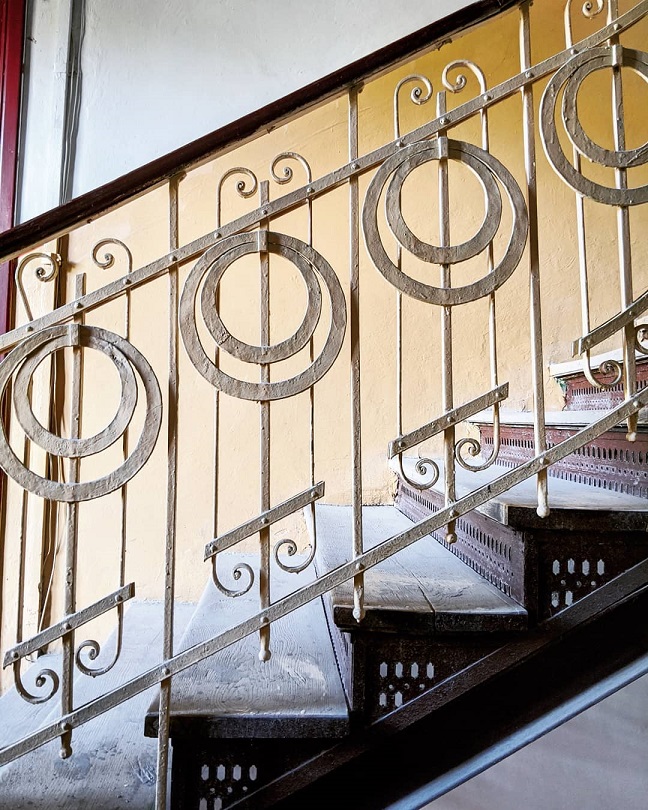

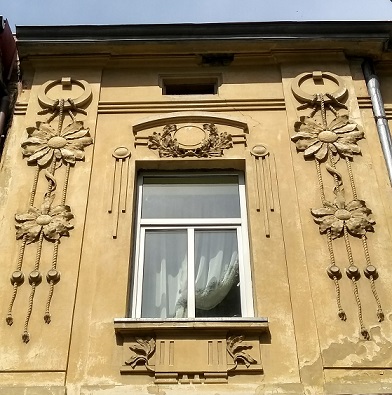
Wall lantern
A source of lighting fixed to a wall, especially to the exterior facade of a building. The light fixture is typically made of metal and decorative, reflecting the architectural style of a building.

Well basin
A remnant of former well, built in the nineteenth century in courtyards or public squares.
